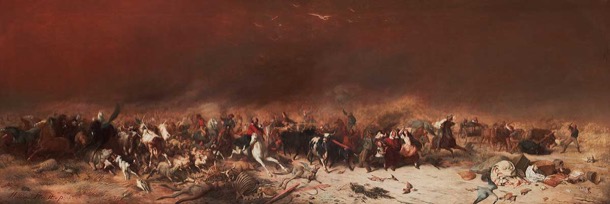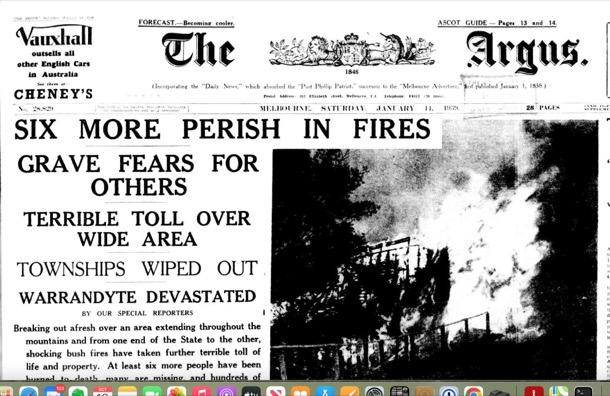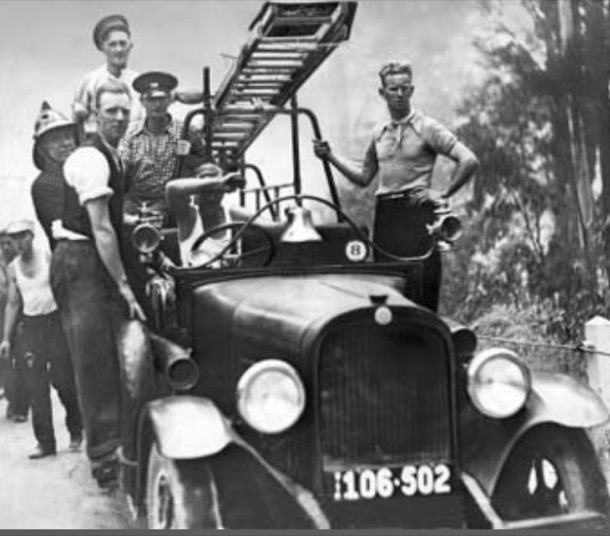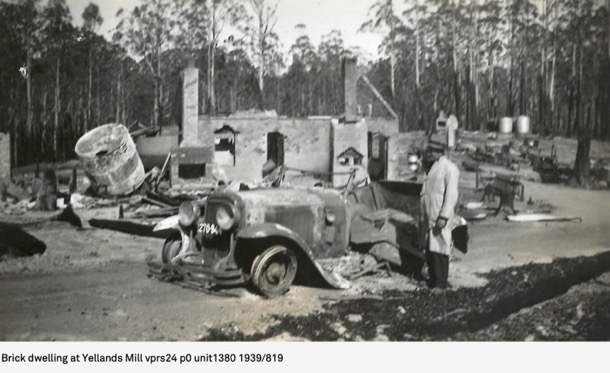Fire and Storm
MY COUNTRY By Dorothy MacKellar
‘I love a sunburnt country,
A land of sweeping plains,
Of ragged mountain ranges,
Of droughts and flooding rains.
I love her far horizons,
I love her jewel sea.
Her beauty and her terror,
The wide brown land for me.
Margaret and I learnt this iconic poem during our respective Grade 6 years and many of its lines are still etched in memory. In fact we can still recite much of it with exactly the same intonation and expression. This poem, written in 1904, captures the tenor of our post, Fire and Storm.
Fire, still very much part of our lives, has also been part of our family history.
BLACK THURSDAY 1851
The first reference to fire was in1851 with the fire known as ‘Black Thursday’.
Painting by William Strutt
This was the first catastrophic bushfire faced by white settlers in Victoria. The lead up to the fire followed what is now a familiar pattern of events. Reports at the time said that there had been wet years of lush growth followed by severe drought, leaving the bush and long grass tinder dry. Thursday the 6th of February dawned hot and windy, and the fires took off, leaving one quarter of the state black and smouldering. Our antecedents, the Bourke’s of Pakenham, were caught up in the fires in a dramatic way. Shortly before Black Thursday the Bourke’s had taken possession of Bourke’s Hotel in Pakenham. Michael Bourke remained at their selection, while Mrs Bourke was to run the hotel and Post Office.
‘On Black Thursday the whole district was ablaze. Mr Bourke was trying hard to save the station property. Water having been exhausted, milk was brought into play and ultimately the run was saved. Word was brought to him that the hotel property at Pakenham was surrounded by fire. Galloping down there, he found his wife and her children had saved themselves by crouching in the water in the bed of the creek.’
We took this photo of the exact spot, during our visit to Pakenham.
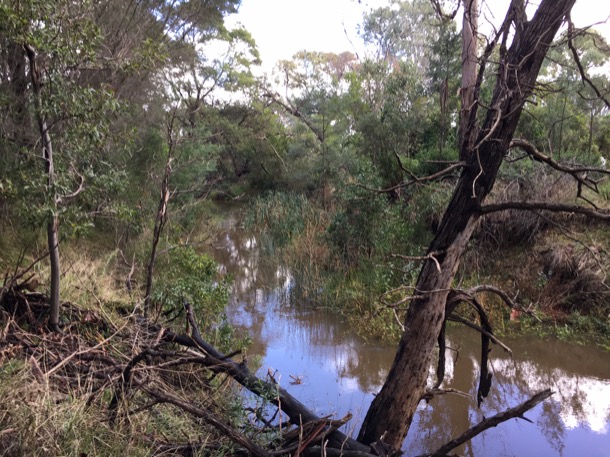
BACCHUS MARSH FIRE 1928
From an article in ‘The Argus' Thurs 12th July 1928
"FIRE AT BACCHUS MARSH.THREE SHOPS DESTROYED"
This was a report on the fire suffered by our grand parents, Alf and Alfreda, in which they lost almost everything, but escaped with their lives. We heard dramatic stories of this fire in childhood and is told below by Marge and Alice on the tape they made in 1990.
The hardware shop was their business, and they had gone out on their own, in an already a difficult time of their lives. Aunty Bert was staying with them to help out, as was her role in the family, as the unmarried sister. Auntie Bert, Alf and Alfreda would have been in their early thirties,Alice was five and Marge three years older. Thank goodness Bert was there as she seems to have had a cool head and took action to get everyone out as the fire took hold.
Marge and Alice’s recollection is fairly accurate, as the newspaper report comments on the strong North wind and the poor water pressure that hampered the fire fighting.
The Argus reports that at one stage,
…. the premises of Mr. G. H. Anderson were threatened , but this danger passed, with a change in the direction of the wind, A good portion of the stocks of Messrs. McLaren and Coates was saved, but considerable damage was done to Mr. Phillip’s stock. It is understood that all buildings and stock, except that of Mr. McLaren, were insured.
At half-past 7 o'clock, in the morning the fire was under control, and all that was left of three of the shops were the walls.’
Mr McLaren may have been uninsured but Alf was definitely not, as he had been unable to pay the insurance. They lost nearly everything.
We had wondered about Alice’s comment about Auntie Bert’s friend Nell Pearce, whose family took them all in after the fire, and yes it was a large and impressive brick house, still standing today: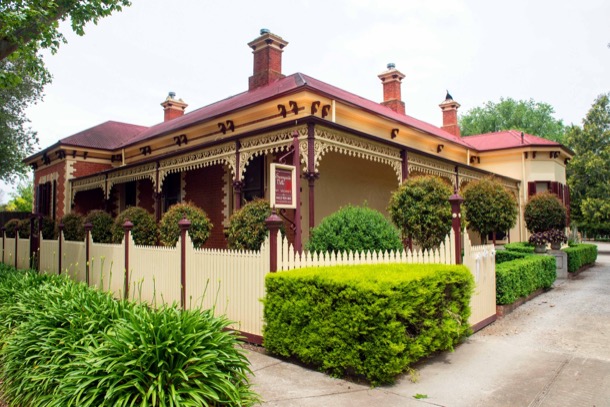
As Alice states the Pearces were an influential family in the town. They had been an early pioneering family in the area. They built and established the General Store that presumably was very profitable, supplying the miners on the way to the Goldfields as well as the local community. The family then went into farming and other small businesses, and were influential in civic affairs.
Auntie Bert maintained a lifelong friendship with Nell, and neither of them married. I remember Nell Pearce being a name mentioned in conversation and I have a vague recollection of her as an imposing figure. I also remember her at Auntie Bert’ s sewing rooms in Camberwell. She was probably there for a fitting. Little did we know the history behind that friendship.
After cleaning up and sorting our their affairs Alf and Alfreda, the girls and presumably Auntie Bert left Bacchus Marsh and stayed with Grandpa and Grandma Holm in Surrey Hills. Alf then got a job in Croydon as manager of the hardware shop, where they spent many happy years.
BLACK FRIDAY 1939
After the 1851 fires, bush fires occurred in many parts of the State with predictable monotony. The next major statewide fire was in 1939, once again after a prolonged drought. High temperatures and strong northerly winds fanned separate fires that eventually combined and created a massive fire front that swept mainly over the mountain country in the northeast of Victoria, and along the coast in the southwest.
Lilydale Brigade 1939.
Source - CFA Website
More than two million hectares were burnt in the 1939 fires.They lasted for a week. Many, unable to be controlled, were left to burn out.
Yellands Mill, where 15 men died:
The extensive damage to over two million hectares of farmland and forest, not to mention the loss of livestock and lives, prompted a Royal Commission. They were tasked with examining the causes of the fire and making recommendations for future management.
The Royal Commission’s specific recommendation was that the various Bush Brigades, and Country Fire Brigades be amalgamated to form a single organisation to fight fire on private land outside the Metropolitan Area. The Forest Commission was responsible for fire on public land and the Metropolitan Fire Brigade was responsible for fire in the Metropolitan Area. Instead of a myriad of uncoordinated small brigades these three organisations were responsible for fighting fires in Victoria.
EARLY BUSHFIRE EXPERIENCE - MARGARET
My first memory of wildfire is of a fire on the empty block next door. The vegetation was sparse: weeds and gorse, with patches of bare clay.
We think it was around 1955. Sue doesn’t remember it, and was probably at school. But I have a clear memory and so I was probably at least four. The image in my mind is of mum, armed with a hessian bag, beating flames. Hessian is a coarse, rough brown fabric made from jute, widely used for packaging. We had a supply of hessian bags, saved from buying bulk chook food. Mum was not a “bush woman” in the Henry Lawson image, but she would have seen this form of fire fighting, and she apparently felt able to take it on. 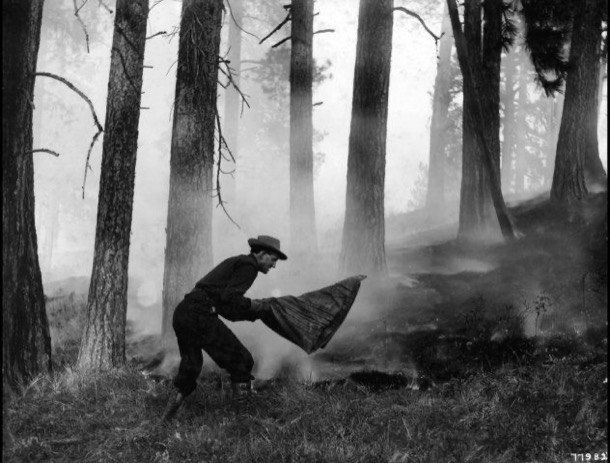
Fire fighting with a hessian bag.
I don’t remember bush fires being a big part of my life as a child, until I was eleven, in 1962. That year was a big bushfire year in Melbourne’s eastern suburbs: 32 people died and 450 houses were lost. Areas affected included Mitcham, less than ten kilometres away from our place. We were never in danger in suburban Box Hill South, but there would have been a red glow in the sky, and the vivid memory I have of burning gum leaves falling in the back yard, is probably from this fire.
In 1979, I moved to the Dandenong Ranges, where the CFA had much more of a presence, and bushfire awareness was part of everyday life over Summer.
In those first few years, there was still on old dugout just over the road in the forest. It had a wooden sign “Dugout” and what looked like a large wombat hole. A closer look revealed a heavy grey army blanket hanging over the entrance. During a fire, this would be kept wet. Inside was a rounded cave, with earthen floor, ceiling and walls. It would have held a maximum of six adults. There was a metal bucket and a pile of musty grey wooden blankets. I guess it might keep you safe while a canopy fire raced overhead, but I wouldn’t want to rely on it.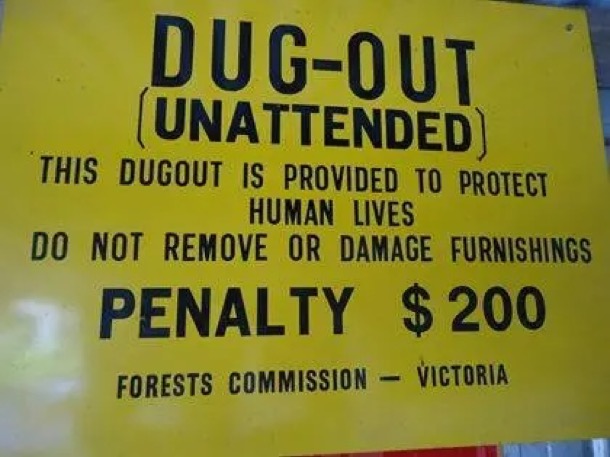
The CFA were, and still are, omnipresent. On weekends they collect donations at major intersections. On Good Friday, and in the week before Christmas, they drive through the streets, playing piped music and rattling collection tins. Their sirens regularly echo through the Hills. We can hear the Belgrave, Upwey and Kallista sirens from our place, and sometimes all three will go off. In the past, the siren was used to call in the volunteers, and on a set night of the week, on CFA practice night, they would test the siren at a set time. We like that the sirens are still used, not so much as a specific warning, but as part of our aural landscape.
Nowadays, when we hear a siren, we go straight to the Victorian Emergency app, to check what has happened. Often it’s a house fire, a car accident, a small bush fire. During the Summer months we are more attuned to the sound. Our practice has long been to evacuate on days of dangerous fire weather.
BLAIRGOWRIE FIRE 1980 - SUE
My only experience of fire first hand, was in 1980 at Janey’s house at Blairgowrie. We had all just sat down to lunch. Anna was nearly three and I was pregnant with Thomas. Everything was tinder dry, as it was January and we were in the middle of the 1979-1983 Eastern Australian Drought.
Halfway through lunch there were loud knocks at the door, and a panicking young man asked us for a hose, as he has seen a small fire beginning to build on the Spray Point Road, just fifty metres from the house. Jono and Janey raced down to investigate, but realised that they had not a chance of stopping the fire. It was spreading quickly, fanned by a strong north wind. This was a stroke of luck as this meant it was spreading away from us and towards the beach. We called the CFA who responded promptly, parking several fire trucks at the hydrant on the nature strip.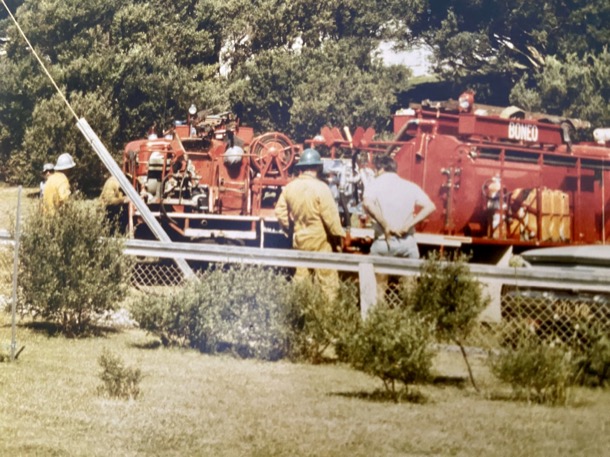
We were told to block the downpipes with oranges, fill the gutters with water, and shelter inside. The fire was brought under control fairly quickly but not before six hectares of the National Park was burnt.
It would have been a different story if the wind had changed and pushed the fire towards Janey’s house and of course all the other houses.
Local newspapers at the time reported on the fire and issued warnings and advice to residents and holiday makers for the rest of the holiday season that was only just beginning.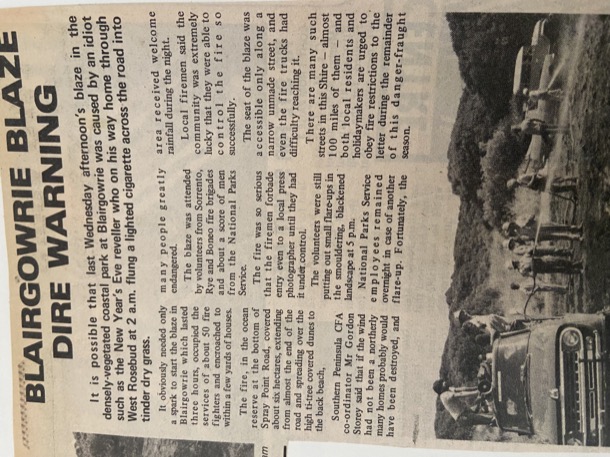
ASH WEDNESDAY
SUE
On Ash Wednesday I was at home with Thomas, as Anna had just started school. Thomas was happily playing with water in the shade of our pergola, as it was a very hot day. A nasty north wind intensified as the day wore on and many fires started across Victoria. I was listening to the ABC afternoon show hosted by Tony Delroy, who, as fires broke out, was reporting the outbreaks in real time. He also took many calls from people desperate for information. There were no centralised communications hub, warning system, or, of course, mobile phones. As the fires continued to burn during the evening and that night, the radio was the only source of state wide information. The 3LO radio hosts worked on a roster system to get the information out.
Since its inception the ABC had been responsible for emergency broadcasting, but only on the news bulletins.. In 1997 Ian Mannix was appointed as Program Director for Local Radio Victoria. He changed the nature of emergency broadcasting during the 1997 bush fire in the Dandenong Ranges. The fires burnt for days, three people died and forty homes were destroyed. Mannix asked the CFA for advice on what to say to to listeners ‘who were confronted with flames.’…Interestingly, the CFA had no experience of giving warnings and had never written a warning for people at risk.
Mannix went ahead and took the lead in creating the ABC’s approach to emergency broadcasting. He developed guidelines that included warnings at set intervals, including bush fire alerts for low level fires and urgent threat warnings for more serious fires. The system used in Victoria was expanded nationally after Black Saturday in 2009. Further recommendations were made by the Black Saturday Royal Commission that future refined and expanded the warning systems to television and commercial radio.
From this pioneering work by Ian Mannix, we now have an Australia wide warning system, and broadcasting training and guidelines in each state.
Ian Mannix oversaw the development and implementation of these systems and deservedly received the Australian Public Service Medal in 2012.
MARGARET
The first actual fire we had to deal with in Belgrave was the 1983 Ash Wednesday.
The name “Ash Wednesday” is nothing to do with ash from bushfires. It’s a historical/religious reference. It happens every year, and it marks the beginning of Lent, leading up to Easter, in lots of Christian denominations. It follows Shrove Tuesday, Mardi Gras … the last day of feasting before the deprivations of Lent. The ‘ash’ is sprinkled onto heads or swiped across foreheads as part of the Ash Wednesday service.
1982 had had a very droughty Winter, Spring and Summer. The little creek that runs through the forest over the road had almost stopped, and underfoot the leaves crackled.
The 1983 Melbourne dust storm, when 50,000 tonnes of Mallee topsoil turned the sky dark brown across the city, happened in early February. For me, it hit as I was crossing Burwood Highway on my way to the Ferntree Gully hotel, for an after school cool drink. The dust cloud was over 300 metres high and 500 kilometres long, and darkened the sky for an hour. It’s one of those iconic events where everyone can tell you where they were when it hit.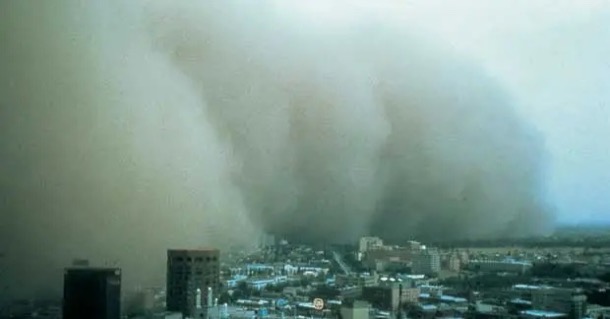
Image credit: Katsuhiro Abe/BOM
There were many fires that Summer. The CFA across Victoria attended nearly 3,200 fires. Wednesday February 16th was particularly hot and windy.
That morning I had woken feeling nauseous and weak. I rang in sick, and went back to bed. Within a few weeks, I would find out that this had been the beginning of morning sickness. Michael was born that October.
Later in the day I had a phone call from a friend who lived locally, suggesting I might consider leaving, as he had heard there was a fire in Belgrave Heights. Outside was stifling. My neighbour was packing her car but she was expecting to wait and see. I don’t remember having any sense of danger, though, later, we learnt that it was only the late afternoon wind change that stopped the fire from sweeping through Belgrave township and on to our place.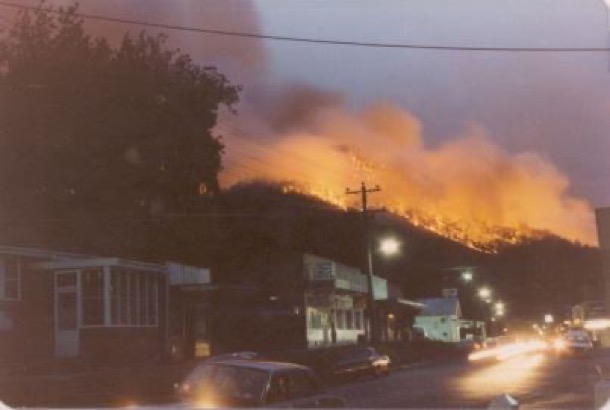
Photo: Tonia Van der Dungen. Christmas Hills CFA
Wind changes during bush fires dramatically widen the fire front, and this one swept through Belgrave South and on to Cockatoo and Upper Beaconsfield.
I don’t remember this, but apparently Ian and Lois were visiting me that day. Lois was pregnant with Sam who was born that winter. Ian speaks of driving home in the afternoon, and taking the sudden decision to drive straight on through Belgrave, rather than the more logical route through to Belgrave South. This would have been exactly the time of day when the fire swept through across the road they would have been on.
Later there were many stories, horrifying and heroic. In Cockatoo, 300 people sheltered during the night in the kindergarten, as a handful of local men kept the flames and embers at bay, saving many lives.
Across Victoria, 75 people died, more than 200,00 hectares were burnt and 2000 homes and buildings were damaged.
Friends from the suburbs rang to check that I was ok. Our little patch of the Dandenongs was untouched, but one didn’t have to drive very far to see the black horror.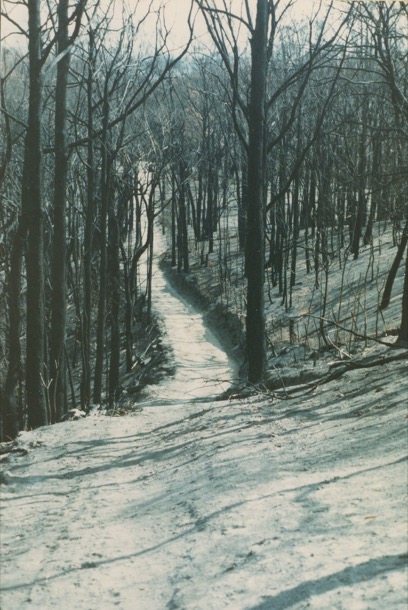
Photo: Critchley Parker Junior Reserve. Upper Beaconsfield CFA
Ten years later, I began teaching at Monbulk College, and some of our students were still affected by their experiences in 1983. My friend and colleague Sarah had her Year 8 English class make a booklet marking the ten year anniversary. Everyone had stories, which the students typed up and put together. It remains an important part of the history of Dandenong Ranges, and other affected parts of Victoria.
The tragic Ash Wednesday fires were like those of 1939 Black Friday in intensity, if not in range. They confronted the modern firefighting community with the limits of its capacity and technology. Among the 75 dead, 17 firefighters died that day, some of them next to their well equipped tankers on a forest road in Upper Beaconsfield, when the wind changed and the firestorm swept over them. Changes in firefighting strategies and philosophies were inevitable. The community needed to be better informed and more involved. This is certainly my experience. I was so naive and ignorant, compared to what we expect from Hills people nowadays! There was a huge Royal Commission.
It seemed, as the Commission heard people’s Ash Wednesday stories, that the most dangerous situations people faced were from hurried departures. People died in their cars, not their homes. But the CFA could not guarantee to be there during huge bush fires, protecting every home.
And then there were stories of people actively defending their homes from ember attacks, and saving them. “People save houses. Houses save people.” was the mantra.
The “stay or go” policy began to be developed. As the professionalisation of firefighting, and the ‘Science’ of fire behaviour developed, ordinary people’s anecdotes were often disregarded as over hyped and hysterical.
There was a huge campaign to teach the population about how to prepare their homes, and defend them. Because it was so centralised, the people who lived on the edges of grasslands and those, like us, in what nowadays we call the “flame zone”, were given the same advice. The “go” part of “stay or go” felt like an afterthought for people who were not able bodied. I remember some of our neighbours’ plans were that the men and older boys would “stay” and the women and little children would “go”.
In 1987 the very first General Achievement Test had as one of its tasks information about how to prepare a home for bushfire. It was clearly in the zeitgeist.
My personal experience of this policy is encapsulated by a CFA Fireguard group meeting, in the years leading up to 2010, that we attended on our neighbour’s verandah. The CFA man explained patiently about how bushfires behave, and how we should be preparing our houses, so that we could defend them. The expectation was clearly that we and our neighbours would stay, in the case of a bushfire, and, with mops and buckets of water, we would put out any embers that threatened out house. We pointed to the towering ash forest, metres from our house, and told him we didn’t think our house would be defendable. He was not impressed.
Throughout the Millennial drought, from 1997 to 2009, during the most severe summers, we kept a trailer full of things at Chris’s parents’ place, and had a very clear plan. We evacuated quite a number of times, staying in their spare room. The plan was to insure fully, and simply not to be there during dangerous times. The local schools built fire refuges, and the CFA kept on with its “stay and defend” message. Water saving advice was everywhere. Like many others, we set up a grey water system to water our garden.
BLACK SATURDAY - MARGARET
And then came the summer of 2008-9. It had been particularly dry and hot. This was the summer when tree fern fronds were scorched, lawns died and record high temperatures were broken day after day. The forecast for the first week of February looked horrendous in advance, with temperatures of 48 degrees forecast, and Chris and I decided to take ourselves camping by the Thurra river, and wait it out. I was glad to be retired by then!
We followed the news of Black Saturday, on the radio, and, once the cool change hit, we packed up and drove out along the Thurra Road, as news of the death toll mounted. Along the Princes Highway, we saw fire fighters’ camp sites with row after row of little tents. The air was smokey, and through the Latrobe Valley we drove through a blackened landscape. At home, the garden was scorched and everything still crackled underfoot.
Back with television coverage, we watched interviews with people who had miraculously survived, saw footage of people’s fire refuges that had been easily breached, and heard the stories of person after person, traumatised by their unsuccessful attempts to defend their homes. 173 people had died, 120 of them in the Kinglake area. More than 450 hectares had burned and 3500 buildings, 200 of them houses, had been destroyed.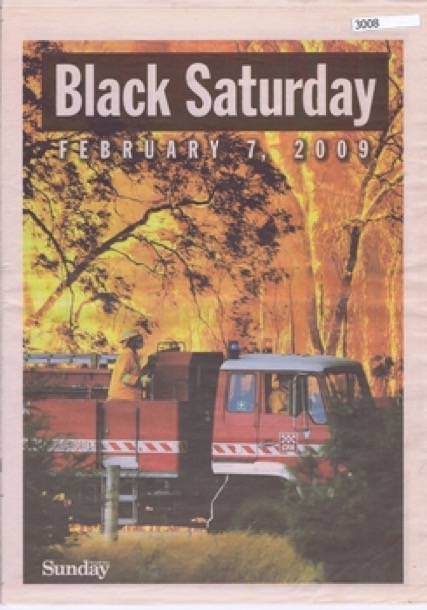
Herald-Sun
That cool change was not the end of the 2009 fire season. We evacuated a number of times that February. One day, a fire bug lit a fire just up the hill from us. I was sitting outside, and heard the crackle as flames licked up a nearby gum tree. Chris was walking in the forest. As I drove down to the Belgrave carpark, he was walking quickly back down through the forest, having seen the smoke. When he met a wall of flames, he backtracked hastily, headed toward the road, and hitched a ride with a stranger to near home. The wind was blowing the danger away from our place. I have been mocked mercilessly for my paper post it note on the door telling him I’d gone to the Belgrave car park, but at least he knew that I was out of danger.
In the car park, a gaggle of us watched the Elvis fire bombing helicopters head up the hill, and cheered, and very soon the whole drama was over.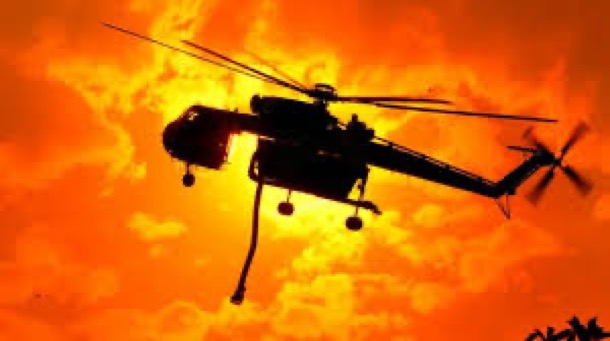
2009 marked the end of the Millennial drought years. Summers since then have been cooler and wetter. But the legacy has been an obsession with rainfall figures, forecasts and climate outlooks.
Our local community facebook page has a member who is a forecaster with the Bureau of Meteorology, who posts every time there is a weather anomaly. It is clear from the responses to him, that we are not alone in our anxiety about rainfall.
THE BIG STORM - MARGARET
It was winter, 2021. There had been yet another Covid lockdown, this one lasting two weeks, finishing on June 10th. Life quickly went back to normal for most people in Melbourne.
But for us in the Dandenongs, the evening of June 9th, and the next morning, brought a massive windstorm which brought down huge swathes of trees, many across roads and onto 112 houses. The wind came at 120kph, but it came from an unusual direction, and our shallow rooted mountain trees were largely untested from that direction. They fell, roots and all, in their hundreds.
Even though the power went off immediately, and all the mobile towers were out, there were 9,500 calls for help logged by the SES. People were trapped in their houses, and many streets, including Michael and Katherine’s were blocked off. There was no way of communicating, in or out, for many days.
My most vivid memory of the storm comes from early on the morning of the tenth. Chris was standing with a view to the north of the forest out the window. His eyes widened, and yet another a great crash came from the forest. He had watched a two hundred foot tall mountain ash eucalypt gracefully fall sideways, taking down another tree of similar size, which in turn took out another one. Like enormous dominos, the three of them had joined the huge pile of previous victims on the forest floor. Later on we stood on the road, looking down where they had fallen and counted thirteen giant trees lying in a messy tangle.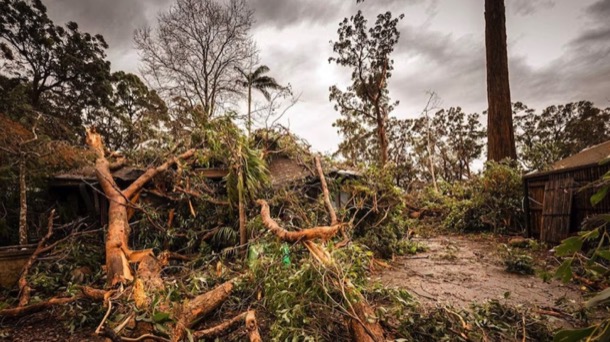
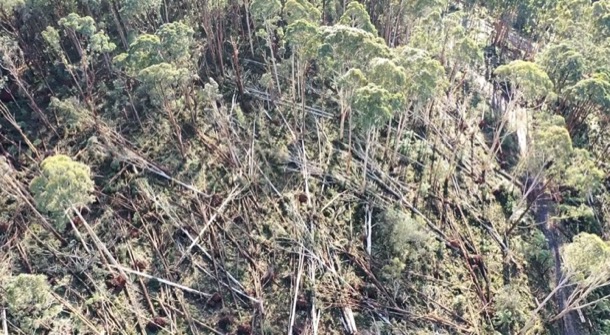
Elsewhere in the Hills, this carnage had been repeated in town after town. We lucky ones who still had homes, watched with dismay as the power company’s estimates of power restoration stretched out beyond a week. Eventually we were able to drive out. It was a weird feeling to drive down onto the flat and find life going on as normal. For us the feeling was very much as if we were still in lockdown. On the Monday evening, I went to choir rehearsal in Ferntree Gully, blinking in the unaccustomed bright lights. Many of us Hills residents had brought items to be recharged during the evening. At end of the night we drove back up into the darkened Hills.
At home, we went into camping mode. There was no hot water, but we had plenty of fire wood, and our very effective wood heater. We cooked with gas and our little portable gas fridge kept our essentials cold. I took to having my bucket bath in the afternoon, when it wasn’t quite so cold in the bathroom. It was ten days before our power came back on, on June 20th.
The reprieve from lockdown lasted only a month. By July 16, Melbourne was back into working from home, home schooling, and leaving home only for essential purposes.
Infant Jesus Catholic Church, Koroit
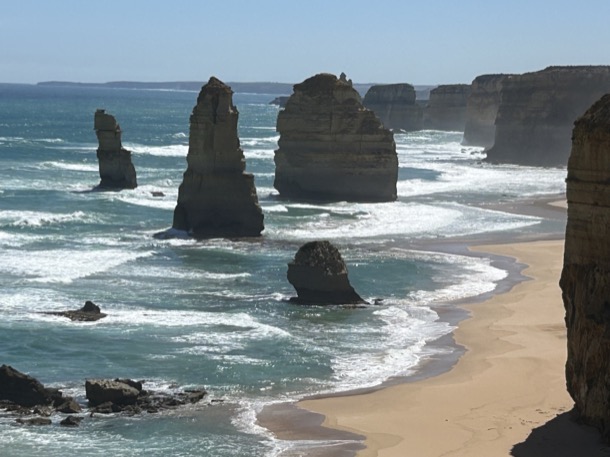
We began with the limestone stacks around Port Campbell and then into the primeval rainforest to Cape Otway lighthouse station.
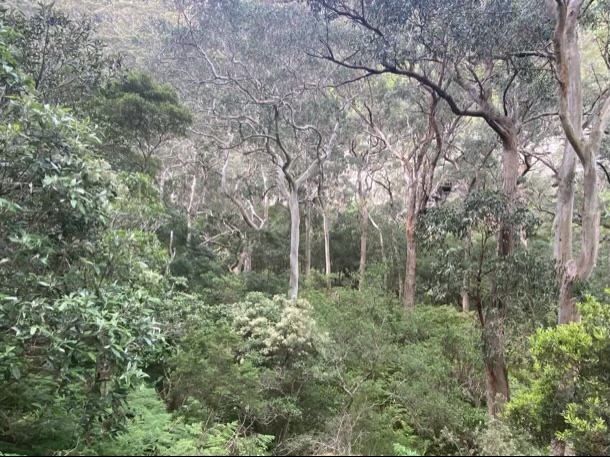
We were on our way to Penola in the Coonawarra wine region. Google maps devised a very interesting route that took us on minor roads cross country… so interesting, varying from poor dairy, in marginal swampy land, to the red gum studded grassy plains of the western district squatters.
We passed the remnants of the volcanic eruptions; the swamps and billabongs, once much more extensive; and wide river valleys, carved out over the millennia. We marvelled at the extent of the Phragmites australis. (wetland grasses) We wondered what this entire landscape was like, prior to white settlement.
Thinking of the past and the history of the area, I was quite in the mood to reminisce about Dad as a boy, travelling to Warrnambool, especially as Google maps was taking us through Koroit where he was born. “I’ll take a photo for Margaret, let’s find the Catholic Church.” I thought.
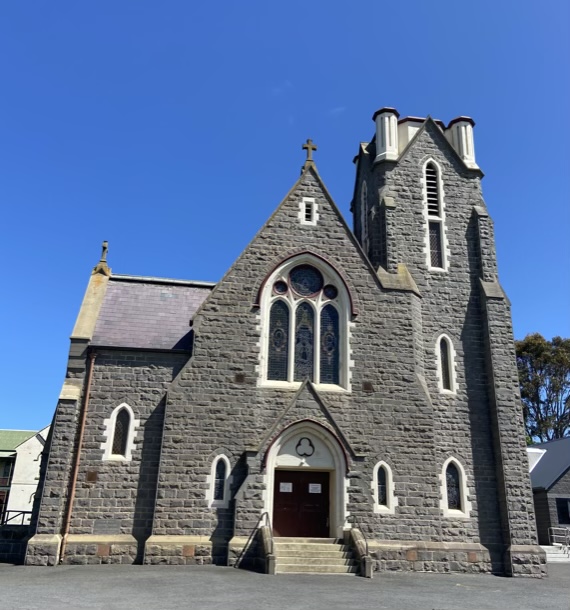
The Catholic real estate occupies a large area of high ground in Koroit. The substantial bluestone church is typical of the area. As we drove up, we noticed the nearly rebuilt St Patrick’s Primary School directly opposite. Dad went there.
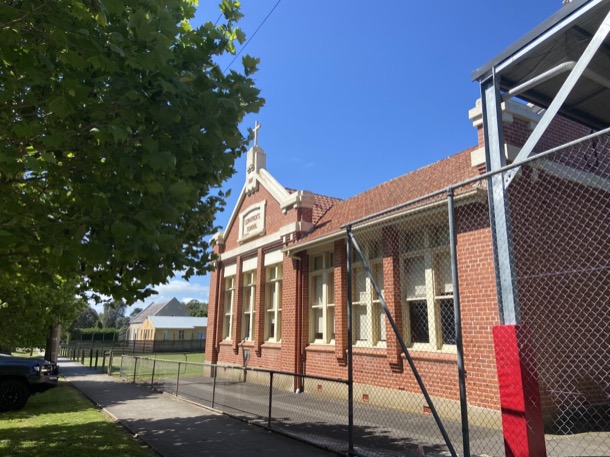
We turned and went through the church gates to the front door, and I imagined Dad and his family walking up the worn bluestone steps to Mass on Sundays. Very substantial grounds with beautiful large trees surround the church, and behind it is a large gracious building, also set in a large garden. This was the presbytery where the priests lived. It had a separate impressive driveway, flanked by large gates, and a long tree lined drive.
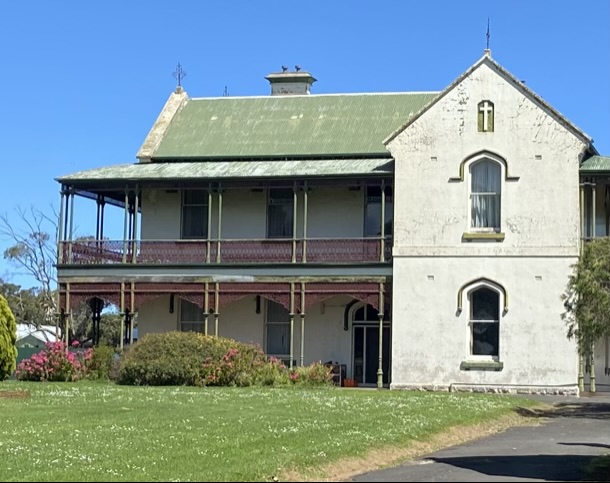
While I was wandering around here, Jono had chatted to the young couple painting the fence. He told her our story and she immediately offered to get the key so that we could go inside.
The door she unlocked was at the back of the church, and was where the priests would have entered the church to robe up. It sent a bit of a shiver down my spine as I thought of the stories of abuse etc. We entered the church, and, immediately in front of us, was the baptismal font where Dad would have been baptised.

Quite amazing! It is a beautiful interior, especially the wooden ceiling and the stained glass windows.
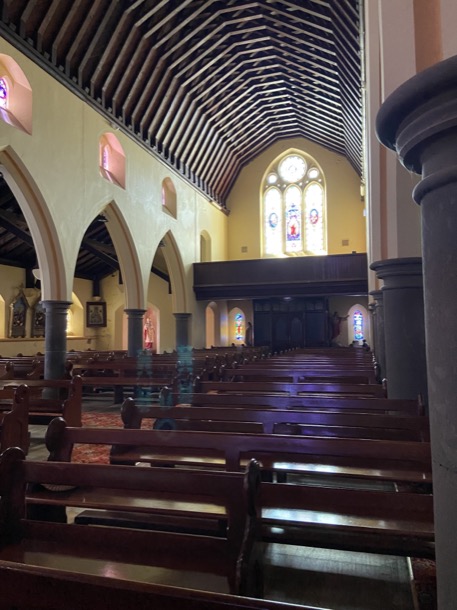
The Catholic iconography was very present in the small side chapels, and the stations of the cross.
I sat in the pews and thought about our family sitting there: a respectable and important family. As the young doctor in the town, Hugh and Grace were building their family and their life here, in this very Catholic and Irish community.
As I was walking down the aisle, I thought of Dad as a small impressionable boy, drinking in all that gruesome imagery of Catholicism, made all the more fearsome in this somber shadowed interior.
We thanked Nicky for opening the church, and discovered that she was a Protestant girl who, as she said, was so in love that she converted, and was baptised and married in that church. Different times and a different story. She also told us that people said that in the past, there were so many priests and nuns here. This is also evident in the large presbytery and convent. The convent is a beautiful, gracious building, also set in a very large garden. It even has a separate chapel.
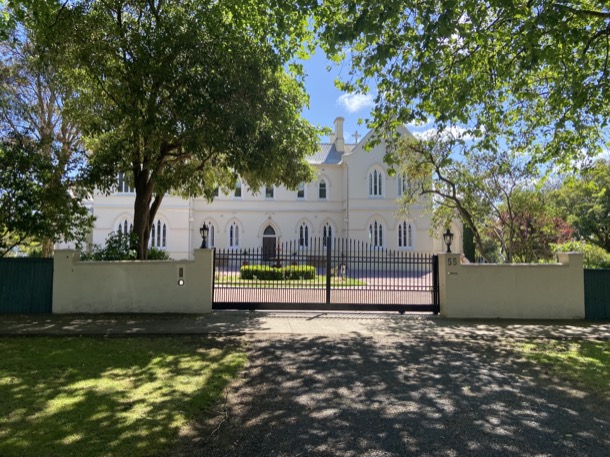
The convent would have supplied the teachers for St Patrick’s where Dad attended primary school. The school has been rebuilt and still has a thriving enrolment.
As I was looking through our photographs, I came across the one of me in the pews looking very comfortable. The thought flicked through my mind that, in another era, the title of “President of the Catholic Women’s Guild” would have been a definite option.
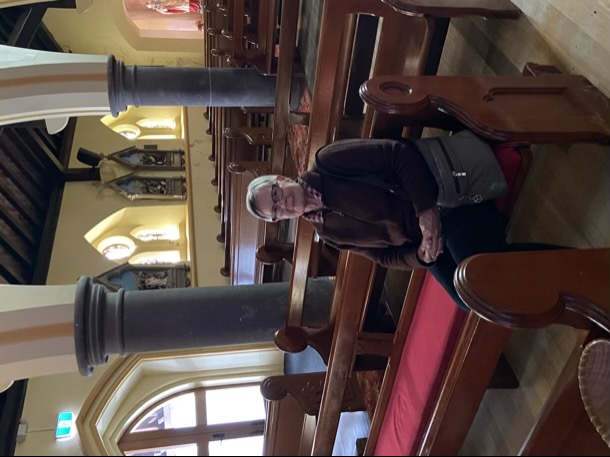
Books of Our Childhood
We are three years apart, and our early childhood experiences are quite different. Despite the three year gap, when we read lists of books for little children, from those times, the same titles resonate for both of us.
As we became independent readers, home time meant being left much of the time to our own devices. The municipal library was our source of escapism, adventure and vicarious happiness.
I vividly remember what I assume was a private, lending library coming to the house with blue covered hard back books for Mum and Dad to borrow. I remember the small van parked at the front door and the gentleman, clad in a fawn dust coat, bringing in the books and inserting the borrowing card in the pocket inside the back cover of items borrowed. We cannot find any reference to travelling lending libraries but we surmise that it may have been an offshoot of a private lending library located in Canterbury Gardens. Public lending libraries were not established until the 1960s, in response to public pressure. Maybe when Mum and Dad lived with her parents they had all belonged to a private lending library located in Canterbury Gardens, not far from Boronia Street, where they lived.
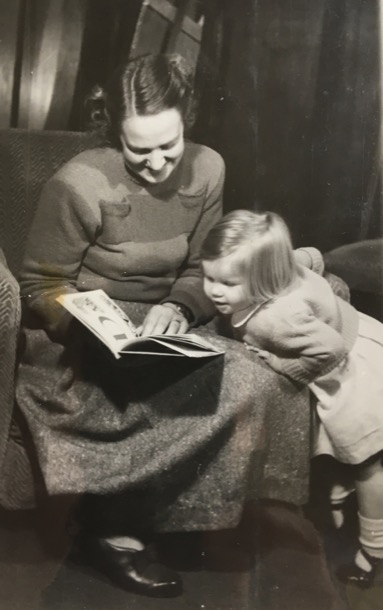
I loved having Mum read to me.
But Margaret was three years younger and her experience was completely different:
“I was just three when the next baby in line was born. He was premature and challenging, and we think our mother probably found the next few years a very difficult time.
In the years before he was born, she read to Sue, and I was there, but I don’t have much memory of it. I certainly don’t have the strong, warm connection to those books that Sue has. And when I was of an age where they would have been appropriate for me, Mum was caught up with managing the baby, and I was pretty much left to my own devices.
I remember, later on, her reading to our two younger brothers, perhaps when they were about three and five years old. But, by then I was reading for myself.”
One of my earliest memories was of the A.A. Milne books. Milne wrote the story of Winnie-the-Pooh for his son, on whom the character of Christoper Robin was based.
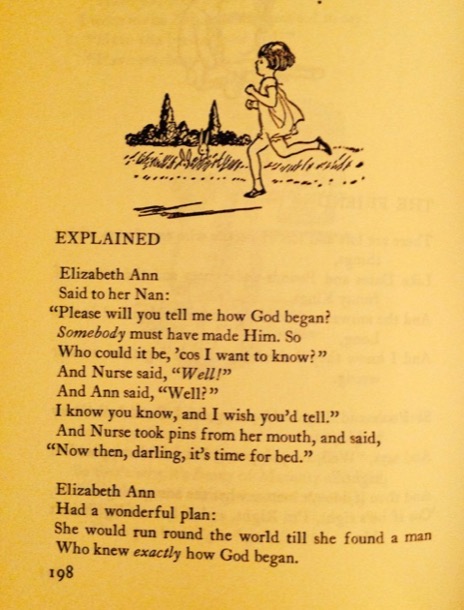
We also had a vinyl record of the poems read by a man, with a very English accent of course. We must have listened to it hundreds of times, as Margaret and I can both recite The King’s Breakfast and some others, with exactly the same rhythm and expression.
My other strong and pleasant memory is of Rusty the Sheep Dog, which is one of the Blackberry Farm series by English author Jane Pilgrim. Blackberry Farm is situated on the outskirts of an unnamed English village. The farm, a sheep and dairy property, is owned by Mr and Mrs Smiles, who have two children, Joy and Bob. Very proper, very white and very English.


From this we graduated to Noddy and Big Ears complete with culturally inappropriate “golliwogs” and apparently a questionable relationship between Noddy and Big Ears. It all went over our heads, as did the racist overtones in Little Black Sambo. Black Sambo was a little Indian boy whose mother was Black Mumbo and father Black Jumbo.
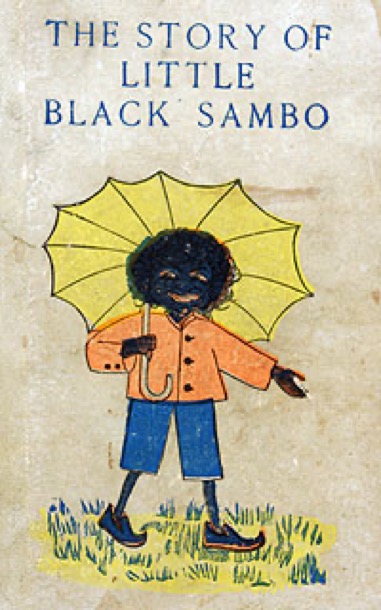
Oh dear! Once again the stereotyping passed us by. Was it maliciously racist or a product of its times? After all, the author wrote and illustrated the book in 1889., in a Britain which had an imperialist presence in India and an Empire ‘on which the sun never sets’.
Our early schooling took place alongside a fair chunk of the population…. the baby boomers were growing up. It was still “post war” enough in the mid fifties for there to be a shortage of teachers. All this was dealt with by adding more and more desks - class sizes were massive!
The range of abilities in each class was, as always, vast. The single teacher was charged with teaching the more than fifty little souls in front of her how to read. There were no remedial classes, no gifted programs and no differentiated curriculum - sink or swim, and sit down and shut up!
At the time we were in the early grades at school, the “whole word” system was mandated. This has the goal of having “the children recognise the word as having a particular shape or contour, rather than decode the word based on individual letter sounds.”
We remember flash cards - words, phrases and then sentences, which, in sing song little unison voices, we “read”, as the teacher held each card up.
“John”
John likes”
John likes to play.”
Then, eventually, we read the whole lot. John and Betty was a portrait of little siblings, stereotyped in every possible way one can stereotype!
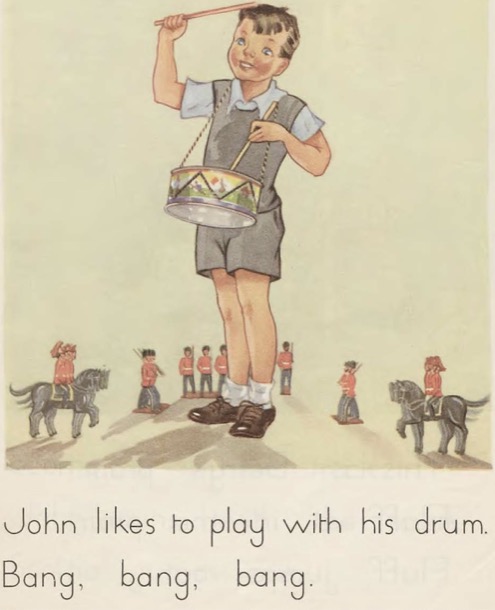
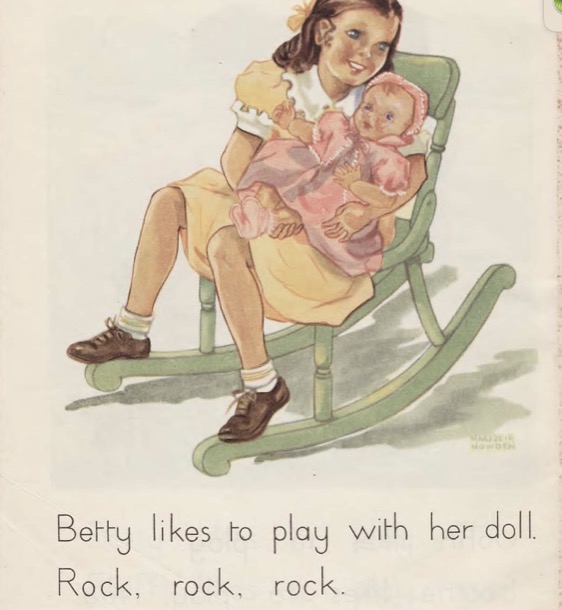
My main memory of this time is … impatience. I don’t really know when the “being able to read” magic happened. I don’t think I could read before I went to school, but the whole process seemed very slow.
It seems we didn’t have access at school to other books, and I don’t remember reading books at home until a bit later. But I wanted to.
Eventually, enough of the class was deemed to be proficient enough at reading to read other things.
The School Paper, a monthly publication of the Victorian Education Department, was first introduced into Victorian schools in the 1890s.They were compulsory reading in schools until 1928, when the Victorian readers became compulsory and the School papers supplemented them. We remember both, and in our memory, the contents was interchangeable.
The school papers were foolscap sized, printed on fairly cheap paper. At the beginning of the year we all bought a black folder, stiffened cardboard with inner strings ready to contain the twelve issues for the year. Sue says she can remember the smell of the folders.
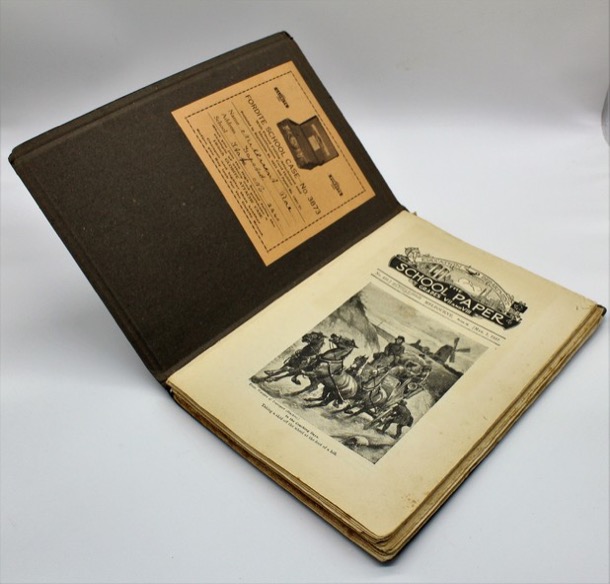
The readers are collections of stories, poems, illustrations and extracts from longer works, twenty-five percent of which had to be Australian. The rest has a very British flavour. The Australian content focused on white bushmen, pioneers, and settlers with a side serving of heroic Anzacs. The Australian landscape was sentimentalised, even while its “taming” was celebrated.
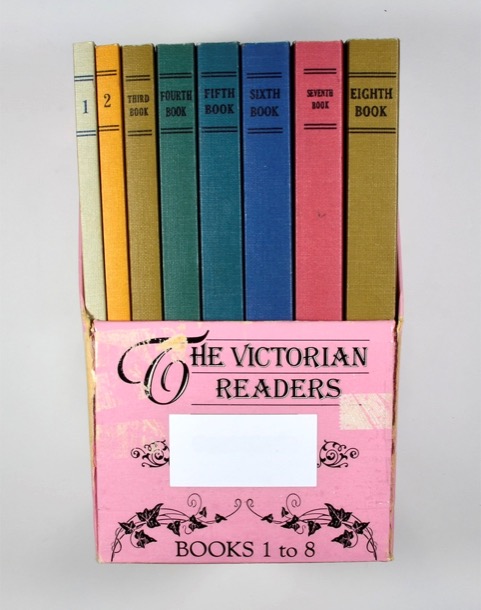
They are an insight into the values and culture that were being instilled into the population, and also into the standard expected at particular levels.
Clearly, quite a proportion of the class would have found the language incomprehensible, and the content alien.
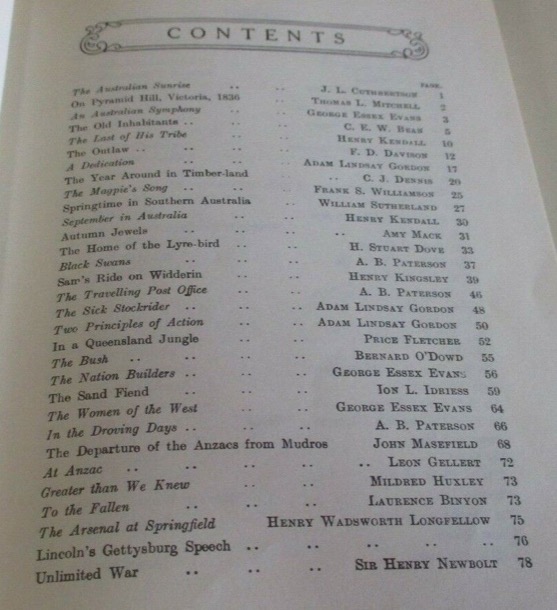
We can only remember reading the School Paper and Victorian Readers at school. And we kept them in our school desk. Did we own our own copy? Did we have use of them just for the school year?
Once we could read, we had a limited, but much loved selection of books.
Enid Blyton was a staple, once again an English author. We particularly loved the Faraway Tree and Famous Five books. The Faraway Tree was a spreading oak, big enough to have small houses in the trunk. It grew in an enchanted forest and its branches reached up into magical lands, in which many of the adventures took place. Jo, Bessie and Fanny, very English children, share their adventures with the magical residents of the tree, such as Silky and Moonface.
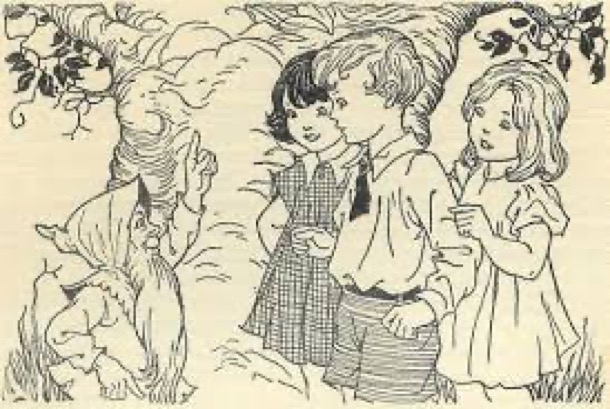
The Famous Five also featured very English children: Julian, Dick, Anne and George [short for Georgina ] and their dog Timmy. Their adventures were much more serious and dangerous, sometimes involving criminals and lost treasure. The vast majority of the stories take place in the children’s school holidays, close to George's family home, Kirrin Cottage. The settings are almost always rural and the children picnic, bike ride and swim in the English and Welsh countryside: very wholesome.
Our grandfather, Mum’s father, also revered books, many with English authors. When we were older we both remember borrowing his books such as George Elliot’s Mill on the Floss.This was a story of Tom and Maggie Tulliver, siblings who grow up at Dorlcote Mill on the River Floss. Another book from ‘the old country’ and a classic of English children’s literature was The Secret Garden by Frances Hodgson Burnett. We read Mum’s copy , a prize from school days. This story is set in a manor house on the Yorkshire moors where Mary Lennox is sent after her parents die in India. She has grown up in colonial India, surrounded by colour and life, and people who always do exactly what she wants, presumably Indian servants. This, like much of our reading matter, reeked of English privilege, class and the trappings of Empire.
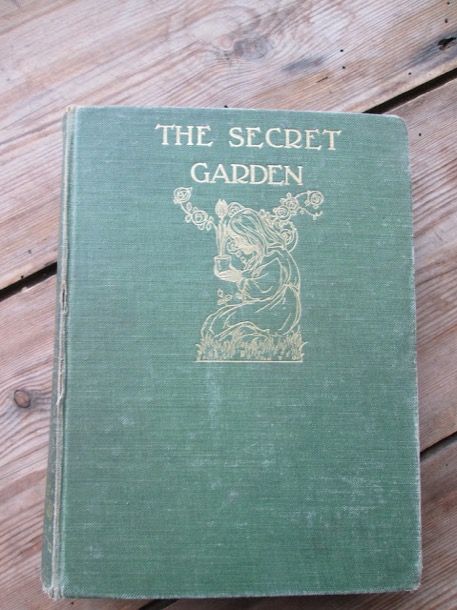
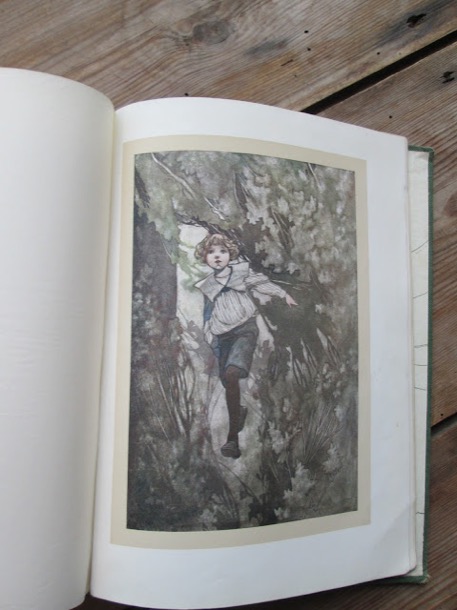
In this environment it is not surprising that Australian literature had similar characteristics. The Billabong books by Mary Grant Bruce, published in 1910, are a prime example. Very Anglo Saxon, gender specific and some would say racist, they represented to our young, innocent minds, adventure, and a glimpse into an idyllic life on a prosperous large property somewhere in Victoria. Twelve year old Norah, the ‘little bush maid’ lives at Billabong Station with her widowed father and brother Jim. Norah rides all over the property on her beloved pony Bobs, joining in the mustering and the “holiday fun” when Jim comes home from boarding school.
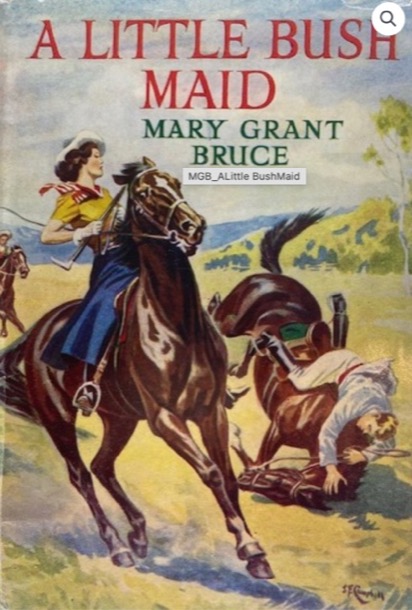
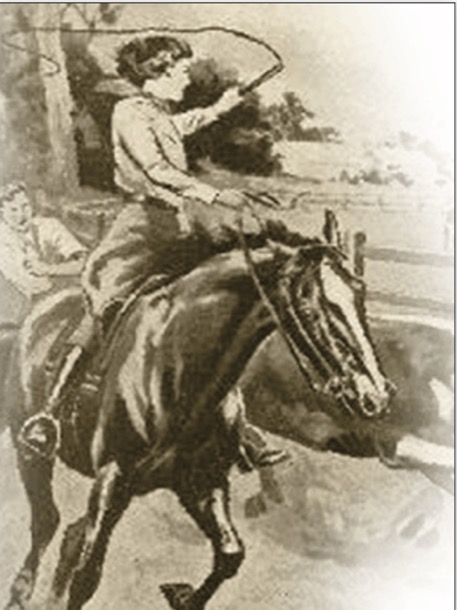
This sums up our own reaction to the Billabong books:
‘The Linton family are very much lords of their Australian manor, ruling in a benignly patronising way.The house, large enough to have ‘wings’, is staffed by a doting cook and various ‘girls’. The decorative front garden is maintained by a Scotsman, the vegetable garden and orchard at the rear are looked after by ‘Chinese Lee Wing (and oh isn’t his silly accent funny!) Numerous unnamed men work the farm itself with one of them, called Billy, seemingly assigned to be the children’s personal slave. Billy is never, ever described without with an adjective like “Sable Billy” or “Dusky Billy” or “Black”. And in case the reader hadn’t quite caught on, he is also variously described as careless, lazy or – just once – as a n——r. At 18 years of age Billy is older than the children and, according to Norah’s father, the best hand with a horse he’d ever seen, yet the children casually order him about and call him Boy. Billy, like every 18 year old bossed by a 12 year old girl, living without friends or family, and with no girlfriend in sight, seems perfectly content with his lot.
But, and sadly there always seems to be a but, my beloved Billabong books belong very much to the era in which they were written. Almost every writer I know cites Enid Blyton as one of their favourite childhood authors. She transported them in a way few other writers could. But almost every writer I know is also sorrowfully aware that once you’ve grown up there is no going back to Blyton’s magical worlds. The racism, the class barriers, the gender stereotypes are just too distressingly obvious to make Blyton an enjoyable adult read. And so it is for Billabong.’
Michelle Scott Tucker [Billabong Series, Mary Grant Bruce 2019]
As well as books, there were magazines.
We struggle to remember exactly how frequently we got the Woman’s Weekly magazine. It came out weekly, until 1982, when it became a monthly. We think our mother must have bought occasional ones from the Wattle Park Newsagent. We don’t think we had a subscription, but it is a very clear memory.
It was an important window into Australian suburban culture.
We remember the sections:
Agony aunt, where people would write in asking for relationship advice.
Household hints
Letters
Knitting and sewing patterns
Fashion and make up advice
Recipes
Health items, discussion specifically about women and children
Probably some Hollywood celebrity items, but we don’t remember having much interest in those
Royals. That was much more our cup of tea. After all, our second names are the names of the late queen and her daughter.
… and of course the ads - mostly household items, fashion and make up.
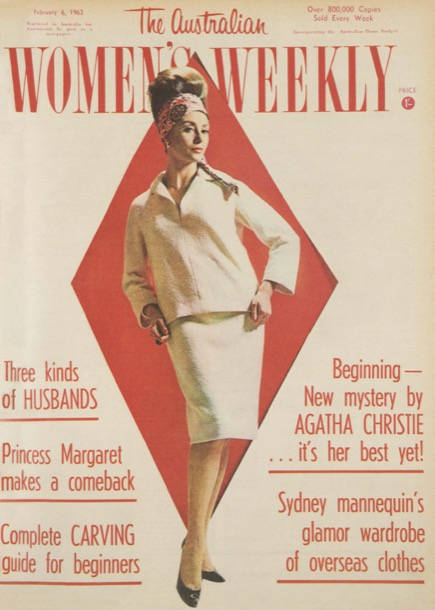
From January 1960, when I was eight and Sue was eleven, we had Princess magazine, a monthly English magazine, aimed at middle class girls. It contained stories, serials, factual articles, all with high quality photos and pictures. Ballet, horses and show jumping, fashion… the content did not have much to do with our own lives, but maybe that’s why we loved it. And there were free gifts!
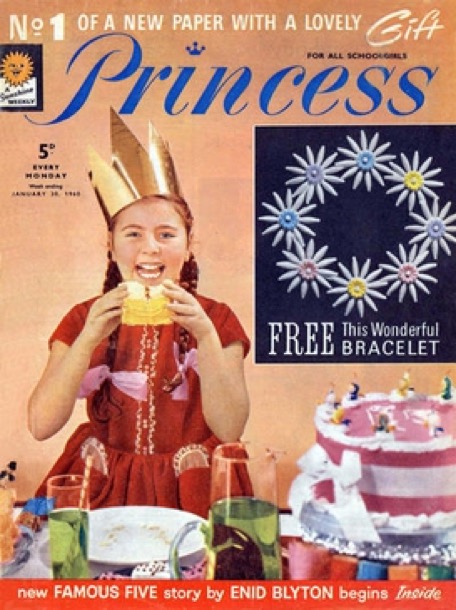
We also loved Schoolfriend magazine and Annuals.
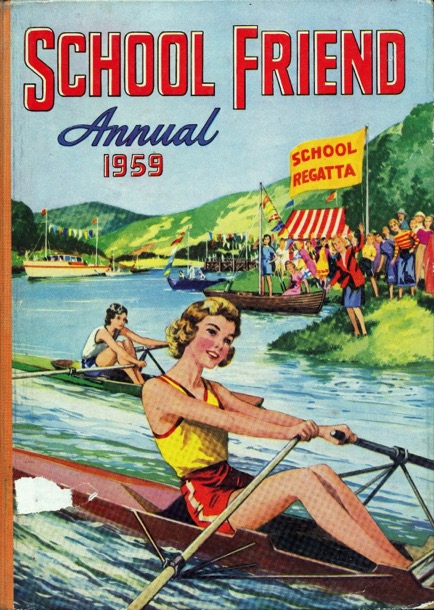
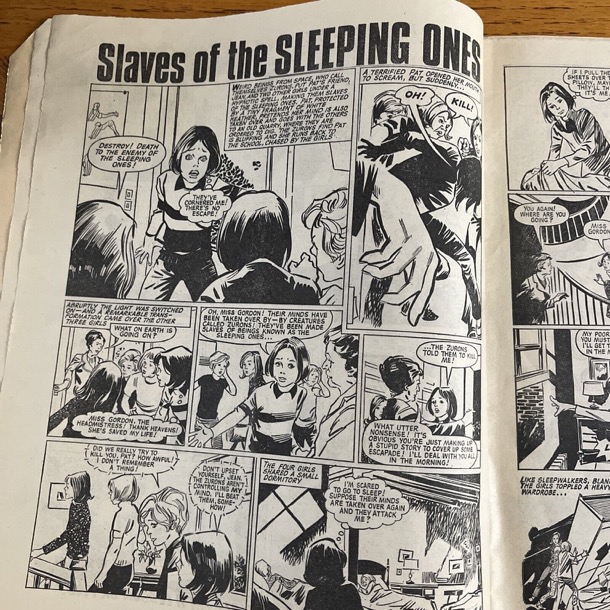
‘Schoolfriend was about the exploits of brave, public school girls at boarding school in England, based on the adventures of pupils in a girls’ boarding school called Cliff House, and featured such characters as Barbara Redfern, Mabel Lyon, Jemima Carstairs – who wore a monocle and had an Eton crop’.
Although the stories featured scenarios in which most children wouldn’t have participated in the 1950s (horse riding, ballet, skiing in the Alps) there was an interesting message being spelled out: in a school environment devoid of males, females were able to assert themselves and reach their full potential.’
from https://johndabell.com/
There were English Boarding School books, too.
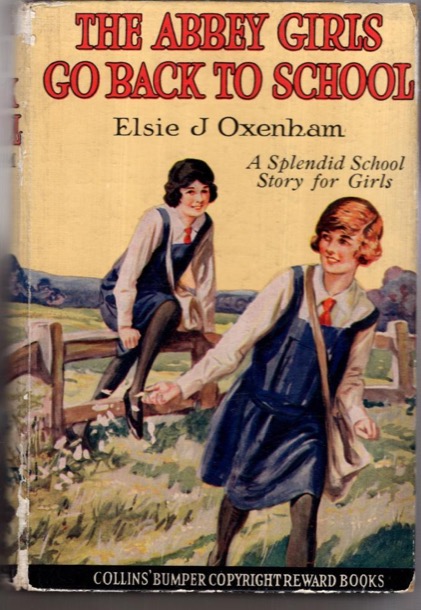
During our annual six week Christmas holiday camping holidays, reading featured heavily.
My memory is of many nights with the family sitting around in the tent, under the central tilley lamp, wrapped in blankets, reading, in silence. When we look at the timing, it probably only happened for a few years, and it would not have included our little brothers, but it feels like a well established custom.
The books lived in a sturdy wooden box, the “book box”, which, Sue remembers, had dovetailed joints. In my memory, we all dipped into it. Maybe our younger brothers were in bed, or maybe they read other, more suitable books. We don’t remember them being read to.
There were a lot of library books, but paper backs featured as well. A brainstorm yields: P D James, Agatha Christie, Ngaio Marsh and other “who dunnits”, Gerald Durrell’s family stories, AJ Cronin, John Wyndham’s Science fiction, Dr Kildare books.
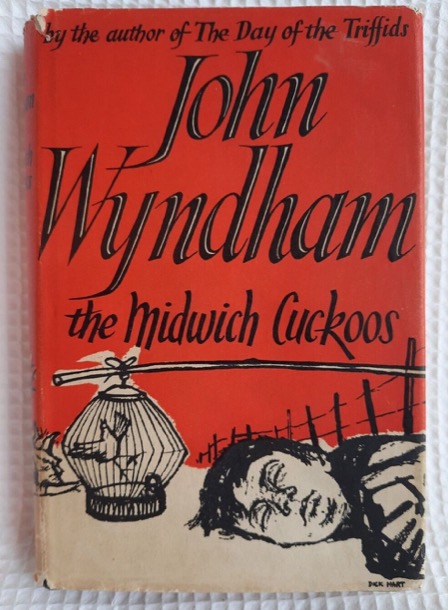
In general, it’s holiday reading, and pretty light. We remember the books being mostly our father’s choice. There were some we didn’t like, such as Westerns, with pictures on the cover of cowboys on horseback. We don’t remember any censorship, but maybe it was subtle enough for us not to have noticed.
Camping holidays are the only time either of us can remember reading Mum and Dad’s books. We can’t ever remember not having access to books though. As a family we didn’t own many books, we all used the library.
Visits to the Box Hill Junior Library were a regular feature in our childhood. The library was behind the Town Hall and was a very simple weatherboard structure, but inside it seemed there was a never ending supply of books. I never remember not being able to find a book I liked. Library visits must have been fortnightly as that was the borrowing period, so it is no wonder that I can still visualise the interior exactly.
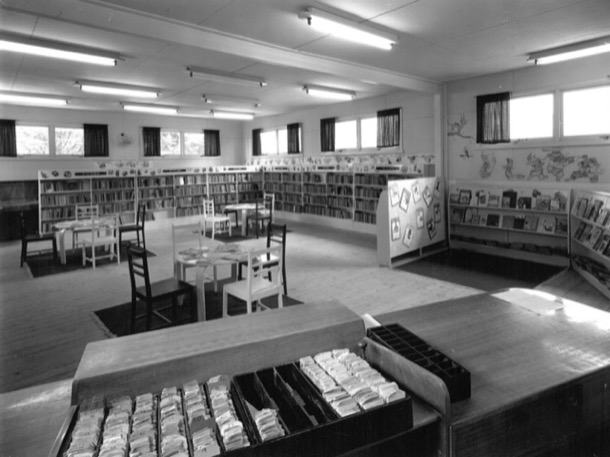
The Billabong books were on the right just past the picture books, top and second shelf down. Once in the door, we would always make a beeline for that shelf to see if the next Billabong book was there. This was particularly important to me as I wanted to read them in order. Margaret does not remember this being a feature of her library visits.
We began this exploration of books in our early life full of the warm memories of specific titles. We already knew that, in our childhood, books were our escape, our entertainment and our cultural education. We buried ourselves in books, and we both remember many hours reading on our beds transported to other worlds.
Over the time we have been talking and writing about this topic, we have realised that the genre that most captured our imagination, and has remained as treasured memories, was actually quite narrow. It was characterised by adventure, characters who were resourceful and brave, often female, and idyllic settings. The action often happened in school holidays, sometimes on islands and beaches or Australian cattle and sheep stations.
We are also struck by the narrowness of the cultural values. We think of our family’s values as progressive, liberal and inclusive. We witnessed no open discrimination in our white suburban neighbourhood. And now, we are surprised at the extent of the sexism, class prejudice and racism in beloved books. It all went completely unnoticed at the time, but our adult, twenty-first century eyes look aghast at the world we immersed ourselves in.
Pins and Needles
SUE
Although I have grown up with sewing and sewers in my life, it has never captured my interest, until recently. I have horrible memories of sewing classes in Year Seven. We were supplied with rectangular brown, cardboard sewing boxes, which held all our supplies and the current sewing task. All went relatively smoothly during the first half of the year as we learnt to use the machines and made our cookery apron and cap for Home Economics classes in Year Eight. Then we graduated to making a white, lawn, lace trimmed slip with french seams.
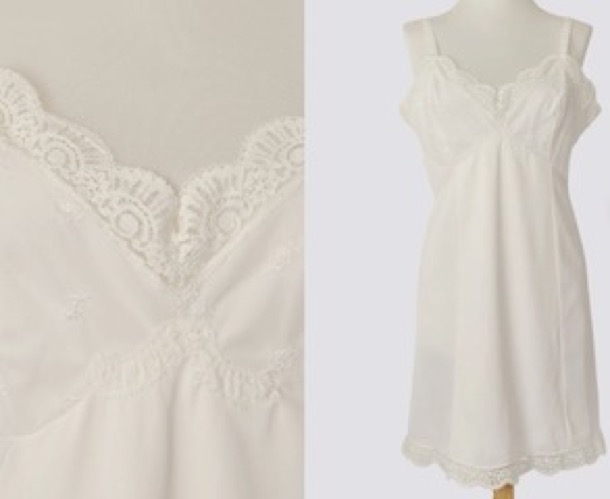
I must have made several mistakes and had to unpick the french seams around the bust several times and my work became very grubby and worn. I looked with envy at the neat and pristine garments of some of my classmates. Starting again was not an option so I decided to smuggle it out and fix it at home. This was strictly forbidden! In the general busyness in the storeroom as the girls put their sewing boxes on the shelves, I hid the offending item under my blazer. Even at home it was very difficult to resew neatly, because of all the needle holes and general grubbiness. At least I could move on with the easier straight seams and the hem. Thank goodness I was not caught smuggling the sewing back into my sewing box. I finished the garment but never wore it. I am sure I would only have received a D, which I would not have liked.
My next foray into sewing was in the first year of my Art and Craft course. The first year was “dressmaking”. I did not enjoy it much, but it was not horrific, as the petticoat had been. I certainly did not want to teach sewing, and I was never asked to, thank goodness.
Surprisingly, I have recently started sewing again. I, like many others, started sewing in lockdown during the Covid pandemic. I am part of a widespread sewing resurgence, facilitated by the technological advances that give me access to fabrics and patterns all over the world and in Melbourne too.
Choosing the fabric and pattern are the aspects of dressmaking that have changed the most. For instance, I recently bought a winter coat pattern and fabric. Once, I would have gone to a local shop and leafed through thick, well thumbed and worn.pattern books by Butterwick, McCalls and Vogue.
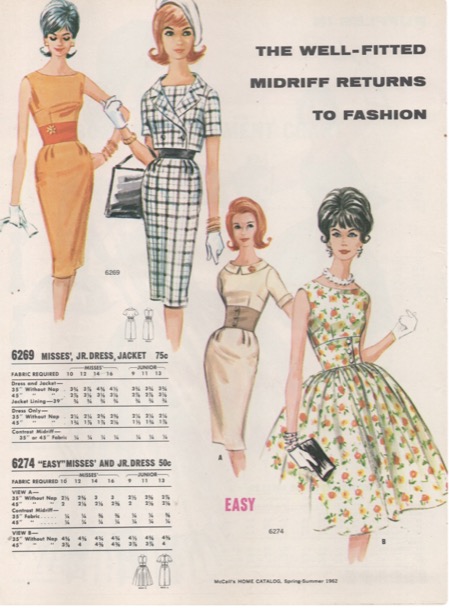
Instead, I chose my vintage coat pattern online, from a business in Germany. It was converted to a PDF format and delivery was almost instantaneous. Then the fun began as the pattern had to be printed. Two options were available for printing. The pattern could be printed on a home printer in A4, with the disadvantage of the pages needing to be joined with sticky tape. The alternative was to go to Officeworks and have the printing done for me, as one large sheet.
I have also discovered the joys of shopping worldwide for fabric. One of my favourites is a haberdasher in Hull in the UK, whose ethos is the creation of long lasting, wearable clothes from their patterns and their sustainably and ethically sourced fabrics. Merchant and Mills is part of a worldwide niche market, that is a reaction to the fast fashion industry, where very cheap, mass produced garments are expected to be thrown away after only a few wears.
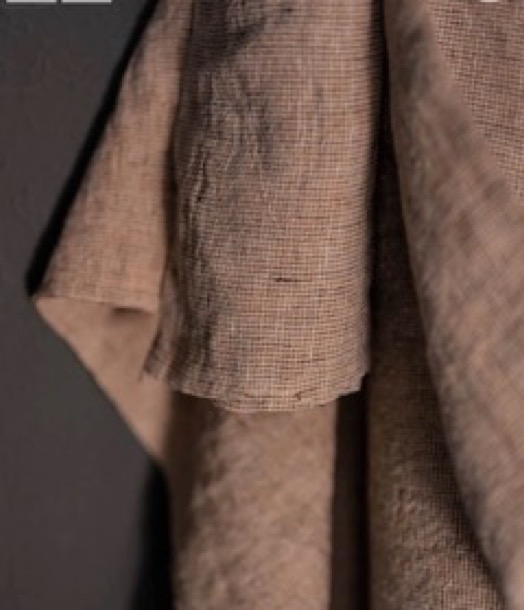
‘This European laundered linen, tumbled at the mill for softness, is a dusty peach and dark brown. It is produced in small batches in Eastern Europe where there is a strong heritage of spinning and weaving linen fabric’
MARGARET
One of the joys of retirement is having time for the little ones. For me, this included making special things for them, mostly sewing and knitting, and always geared to their particular interests and preferences.
Sometimes the occasion was birthdays and Christmases, but sometimes special requests came my way.
The first of these was a Christmas: matching pink fairy dresses for the three little girls. Here is Harper in hers:
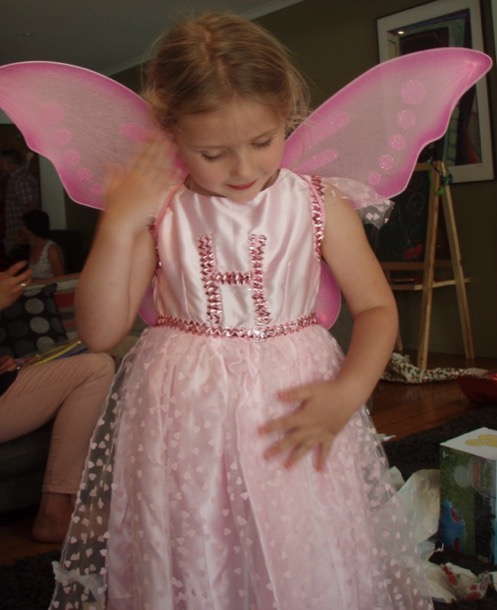
Later on, Harper’s colour preferences changed. For more than a year, she was all about cyan. You and I might have called this colour aqua or turquoise.
This was the colour specified for her special request for a jumper with a bunny on it for her, and one with a girl on it for her bunny.
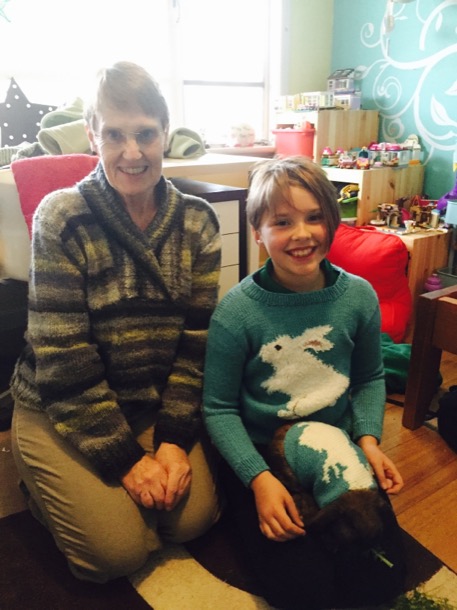
Aurelia was exactly the generation to be all about Disney’s Frozen. Her first frozen dress was a bought one, and she wore it out, before she tired of it. Thus it was, that my first Frozen job was to rehabilitate it:
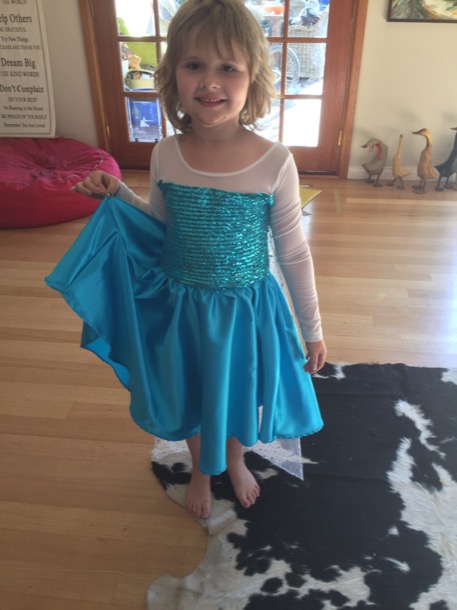
Then, when Frozen 2 came out, with that green dress, Aurelia and I trooped off to Spotlight to choose fabrics for her new one.
Here, she models the front and back of the final product:
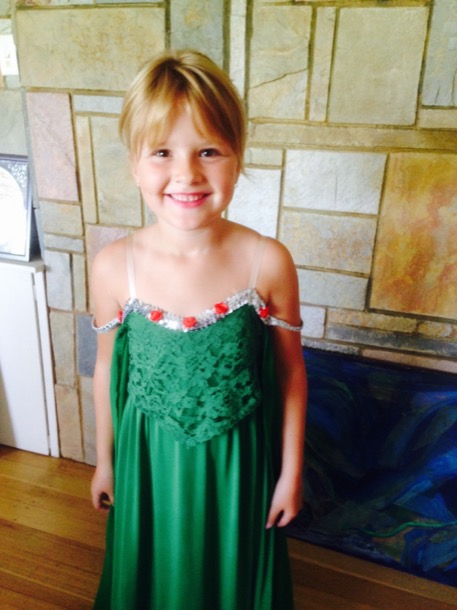
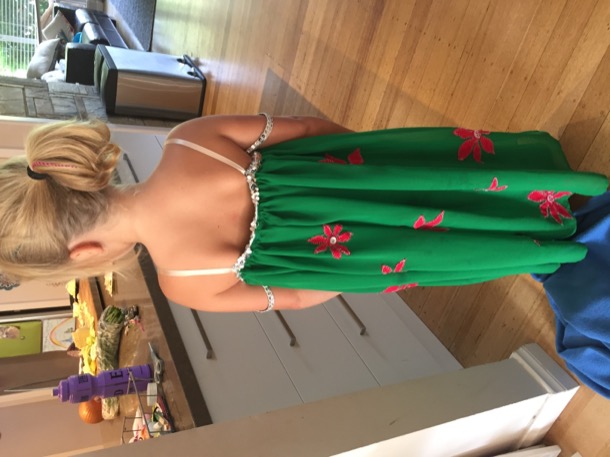
When my own grandchild came along, son of an artist, my initial contribution was a lacy baby blanket, not baby blue, but dark grey.
His first winter coat was also designed by Katherine, and made by me:
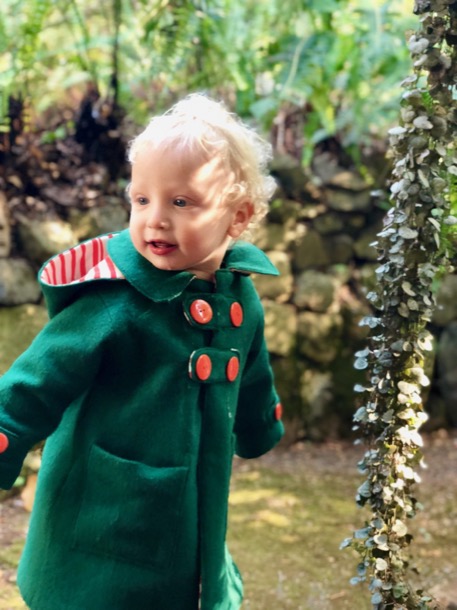
After a while I began knitting him jumpers to match his preferences.
The first one was Percy, his favourite Thomas the Tank Engine character:
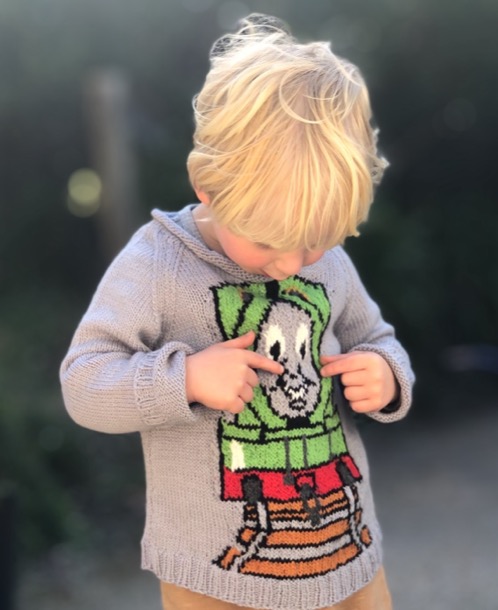
Then Bluey:
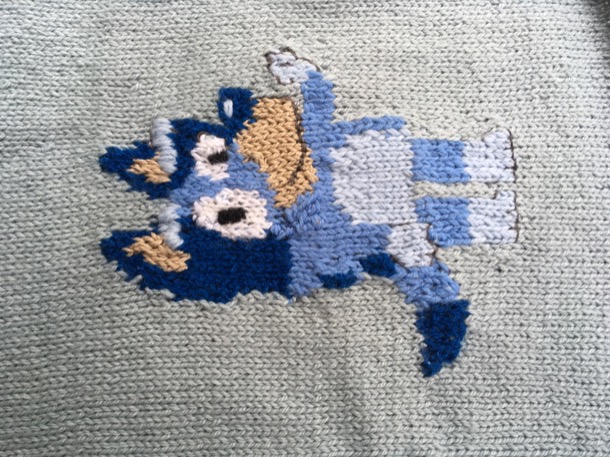
Optimus Prime:

And, the most recent, a Minecraft T shirt, with, by request, a Sniffer:

THE ACCIDENTAL CRAFTIVIST.
In 2013, Chris and I became involved with the community protest against the building of a McDonald’s in Tecoma.
Over time, this evolved into groups of protestors spending many hours standing holding signs on the main road, and maintaining a vigil at the back of the building site.
My favoured place was sitting at the back gate, with a camp chair. Of course I took my knitting.
Here is a typical scene from “the site” at that time. The police were frequent visitors. For a long time, there was stalemate. We were backed by the union movement, and no building contractor could be found.
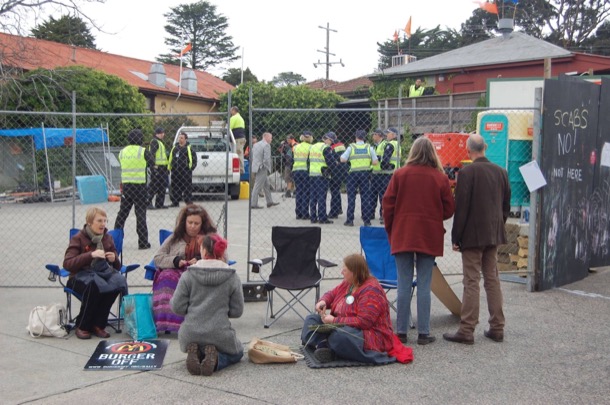
As the building progressed, we were no longer able to meet at the back gate. Every morning my friend Jan put up a little shelter we called “headquarters”. Every truck had to run the gauntlet of polite older women explaining why they should not enter the site.
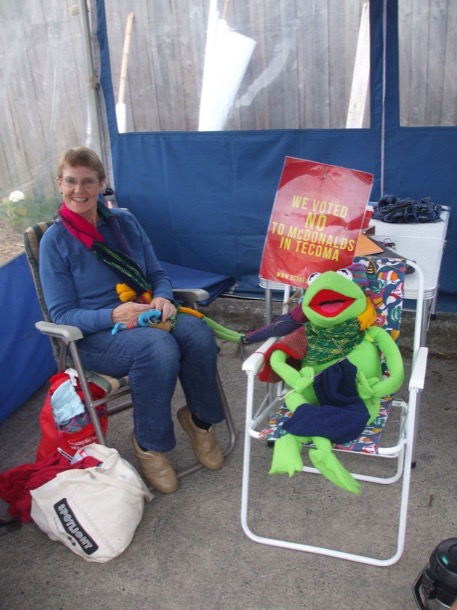
The Banner.
After a while, as we all finished off our various projects, we began knitting squares with all our scrap wool.
We became a group of close friends, and called ourselves The Picket Knitters.
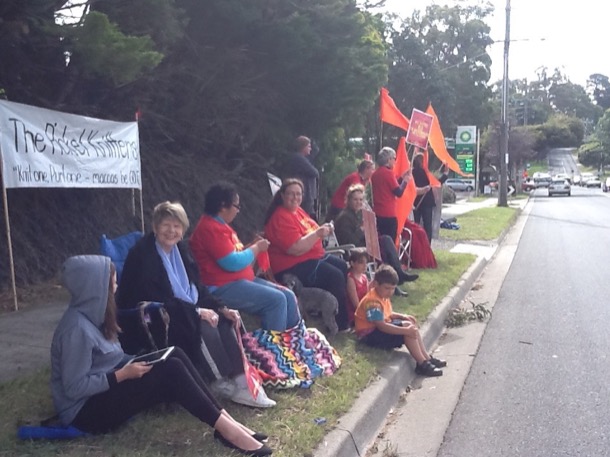
As our movement became more and more well known, we had people from all over the place sending squares. We embroidered the place of origin on some of them. This one came from Cairns.
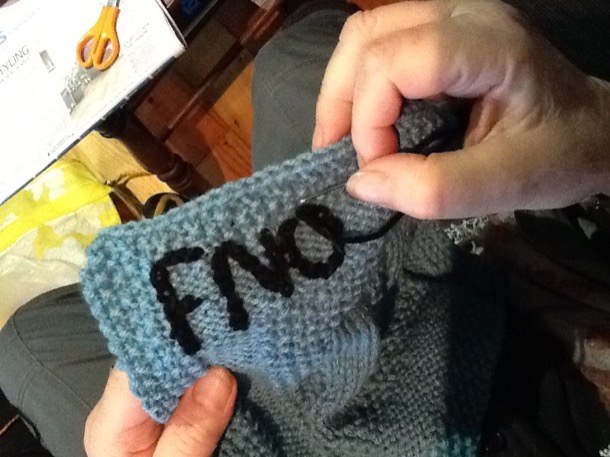
Eventually we put all the squares together, and made it into a banner.
By the time we had the official launch of the banner, the building was under way. Here, the knitters crouch behind the road barrier, with crossed needles. Sue and I are both there.
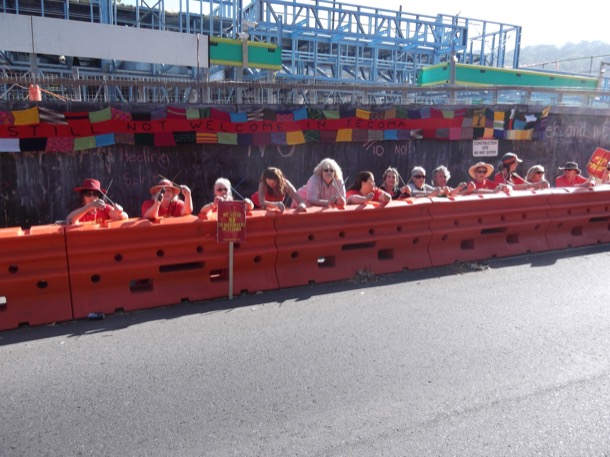
The local papers loved us.
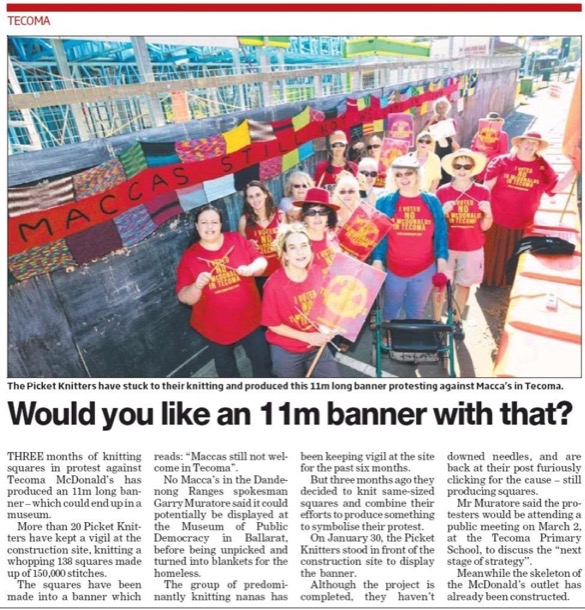
Eventually, we presented the banner to our fellow craftivists, the Knitting Nanas of Toolangi. We reconfigured the squares and it became part of their Great Tree Project.
Here it is decorating the base of one of the precious Mountain Ash trees.

Gnomageddon
“Gnome Maccas”, derived from our “No Maccas in Tecoma” slogan, spawned a range of Gnome related activities. The biggest of these was our Gnomageddon, where the community gathered to break the Guinness Book of Records record of the most people dressed as gnomes.
I made all our knitters a red gnome hat.
Here are a few Picket Knitters in their gnome outfits.
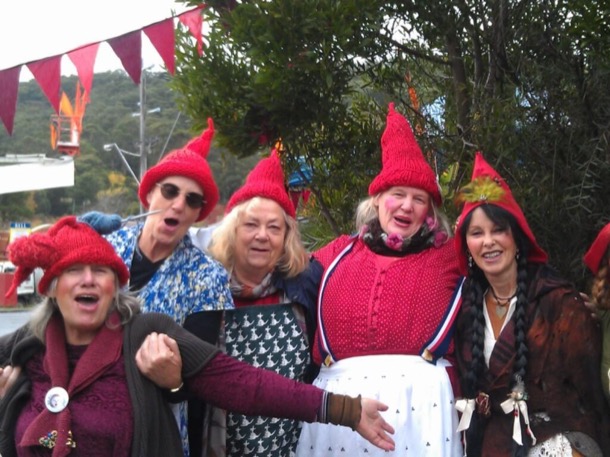
And even a gnome rat.
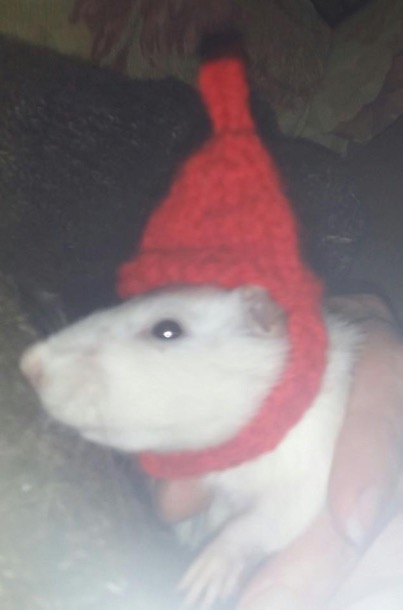
Once the McDonald’s in Tecoma opened, albeit usually deserted and initially the lowest grossing McDonald’s in the country, we continued to meet at each others houses.
In 2016, we all created tea cosies and entered them in the Fish Creek Tea Cosy Festival.
Here is my offering:
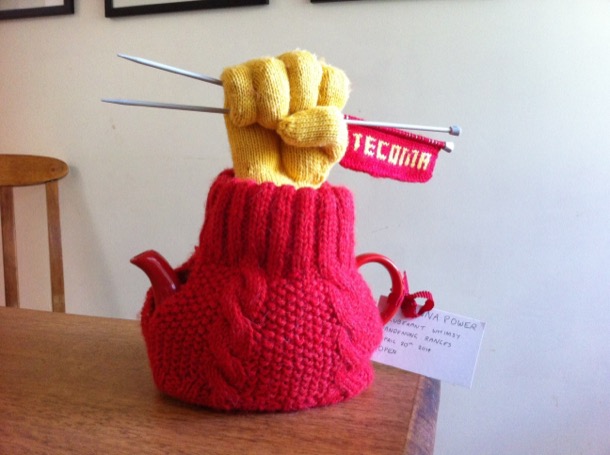
The local paper chased us up to find out what The Picket Knitters were doing now.
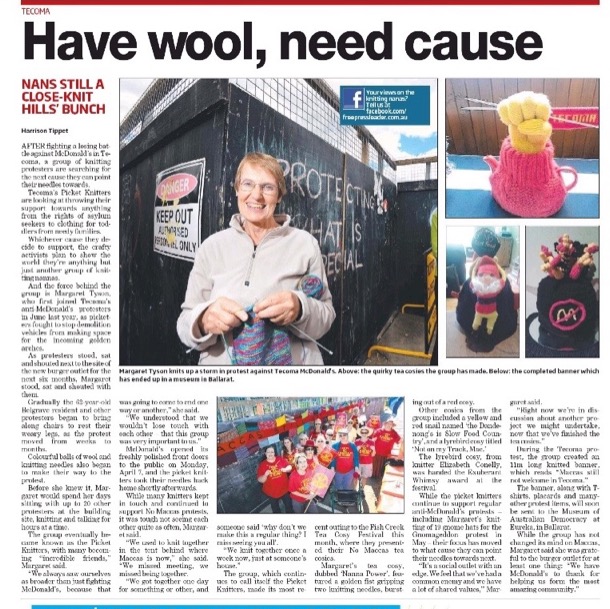
This article prompted a phone call from a Melbourne Radio Station shock jock. Based on the tone of the article, he was very excited by the idea he could paint us as serial protesters for hire. I very much enjoyed my live interview with him, where his aim was completely transparent. When he pressed me for possible “causes” we might move on to, clearly hoping for left wing politics he could ridicule, I listed a range of completely apolitical charities, and played my role of “just an ordinary person” who “of course didn’t want a McDonald’s so near the forest”.
We no longer knit together, but we do meet every fortnight for a lavish lunch and a long chat about how to put the world to rights.
ALICE
This is Sue and Margaret in about 1955.
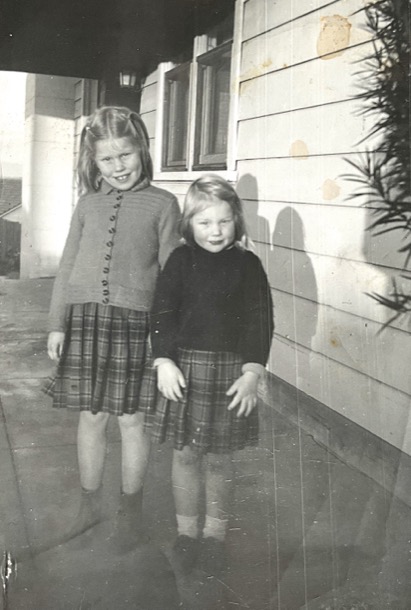
Two small girls, sisters, on a cold winter day in suburban Box Hill in the nineteen fifties.
What does it tell us of life then and the different world we lived in?
From the bottom up, starting with our shoes: We both are wearing lace up shoes, Margaret’s may have been hand me downs. She had a lot of these, as clothes were an expensive item to buy. Mine were my school shoes and these shoes were our one pair: worn to school or kinder, to play, to visit and to church on Sunday. On wet days we wore galoshes over them. These were rubberised over shoes, that fitted over the shoes, saving both feet and shoes from a soaking.
The life of our expensive shoes were prolonged by being reheeled by our father using his shoe last.
He also put little u shaped metal clips on the outer edge of the heel and toes to prevent wear on those vulnerable areas. Amazingly, looking for photos of ‘vintage ‘heel and toe clips I came across a host of You Tube videos of how to fix them to your shoes It is still a thing on leather soled shoes. The two worlds meet.
Our cotton socks were much the same as today. We only had a few pairs. Above these ankle socks were bare legs, in the depth of winter. We both remember cold legs on winter mornings: little girl plump legs with that blueish pink tinge.
At least we had woollen skirts that kept us warm. Once again only one, and home made by our mother. They were always tartan, pleated and then sewn to a cotton calico bodice.
The cotton bodice was at times a little grubby, but was usually hidden under our hand knitted woollen jumper or cardigan. Under this was a singlet possibly woollen. Margaret remembers shocking our mother. School Open Day was quite a big deal with many, mainly mothers in attendance. Mum walked into class confronted by an oblivious Margaret without her jumper on, as it was hot. She was sporting her tartan skirt, complete with a grubby bodice held up at the shoulder with a large safety pin. What a sight!
We think we wore these garments for almost everything we did during winter, from roller skating to going to school. We vaguely remember having twin sets to wear for best with the pleated skirt and a winter coat and raincoat, all worn with.our school, lace up shoes.
And then there was summer sewing.
It’s the week before Christmas. School has broken up, and four children, a dog and a cat clutter up the house. It’s hot, and there is no air conditioning. Not even a fan.
Christmas presents are partly organised but still require a few trips to Chadstone Shopping Centre.
In the garage, Dad is tuning the car, ready for its two hour trip to Shoreham camp. The tent and most of the camp furniture has already been set up, but a trailer full of odds and ends is still to be packed.
The plan is to leave early on Boxing Day.
In the centre of the house, between the kitchen and dining room, is a scene of colourful mayhem.
The sewing machine runs all day and into the night.
Cotton fabrics have been bought, perhaps at a discount fabric shop. They are spread out across the floor, with well used pattern pieces pinned to them. Mum crawls across the fabric cutting out multiple pieces. She makes enough shorts and tops for us each to have a set to wear and a set in the wash. There are hand-me-downs involved for me, the second child.
We find it hard to remember the details of her sewing. How were the seams finished? Were the necklines bound or faced? The hems were all hand sewn: we can both remember hems coming undone.
She didn’t cut the thread ends as she went, there were always multiple loose threads to trim off at the end.
In this photo, taken about 1958, little Sue and Margaret stand in the centre, in that year’s shorts and striped tops.
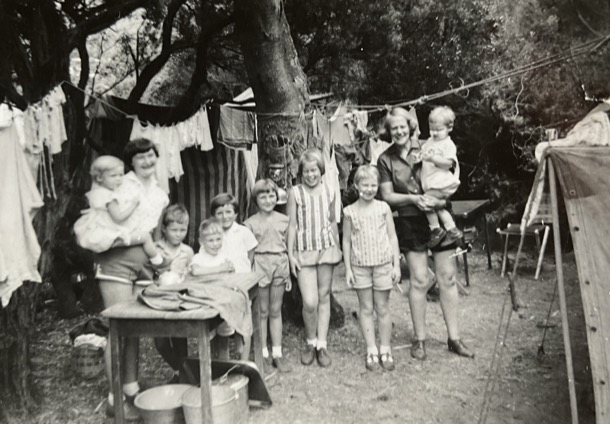
AUNTIE BERT
Our Great Auntie Bert was an important person in our lives and those of our extended family. We have fond memories of her kindness, but it was only as we researched the position of sewing in our family history, that we fully appreciated her dressmaking legacy. We knew that she had had a career as a dressmaker, and had run her own business. She passed on her dressmaking and fitting skills to Margaret and me, and to our mother and Auntie Marge, but we had not appreciated the thoughtfulness and kindness that was an intrinsic part of each garment.
My crushed strawberry viyella dress and Margaret’s mustard yellow check one epitomise this:
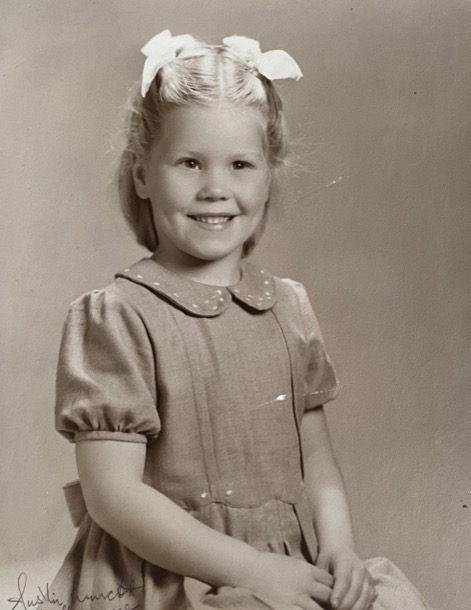
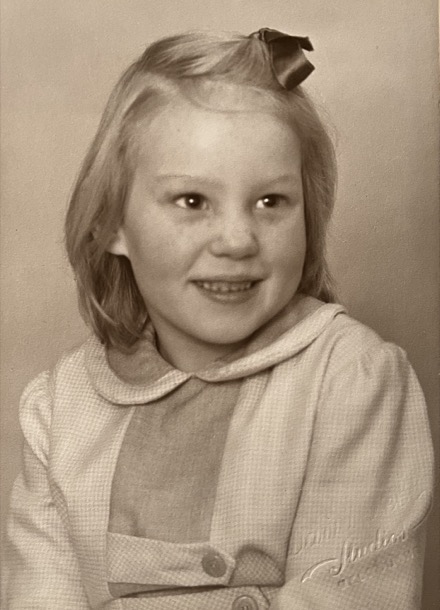
Now that I am sewing more, I can begin to appreciate the level of skill and detailing involved in the creation of these winter dresses. Margaret’s dress is made in a mustard check with a plain contrast panel and collar insert, all beautifully sewn and constructed. My dress, in one colour has detailed pleating on the bodice and skirt and a scalloped edge stitched waist that would have been fiendishly difficult to sew. Hopefully Auntie Bert would have enjoyed creating these “best” dresses, in which her love and care for her family are so evident.
Auntie Bert was also called upon to make many “best” dresses for the adult women of the family, some of them wedding outfits.
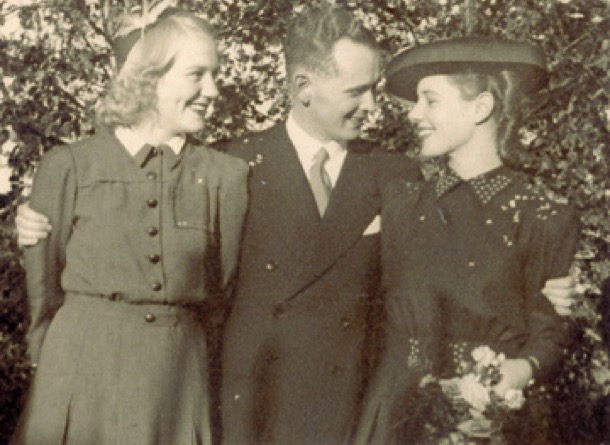
In my late teens when Auntie Bert was living in the flat behind our house, she made me a beautiful tweed winter overcoat , fully lined. I wish I still had it. During the process she taught me some of her tailoring techniques, for instance how to attach hair canvas to the collar , stitching it to ensure an even roll over.
During the last years of her life Auntie Bert lived with her sister’s family at the Cockatoo farm, as we explained in our post ‘Auntie Bert: A Sterling Character.’. During this time she was mostly clad in clothes she had made. In winter, she wore straight woollen skirts and layers of woollen jumpers and cardigans. In summer she wore a dress and cardigan, more often than not, covered by an apron. We never saw her in a beanie, which her sister wore constantly, even inside.
Sewing in many guises has been a feature of the lives of women in our family for generations. Probably there are more stories even further back that we are unaware of. In this short story we have gone from treadle machines, paper patterns and sewing for necessity, to sewing for pleasure and sewing as a form of protest.
Are You Related to the McCormacks?
Now, after months of piecing together the McCormack and Hamilton backgrounds, marvelling at the story of three McCormack boys marrying three Hamilton girls, we were going to visit the actual sites. Very conveniently, we could stay at Sue and Jono’s property nearby. We roughed out an itinerary, and a food and wine list. The forecast was dubious, but we would mostly be in the car. Jono offered himself as designated driver.
On the first morning, we pulled into Molesworth, familiar as the second last town before Sue and Jono’s road. I looked at the hall, right on the main road. We took pictures, and peered in the dirty windows.
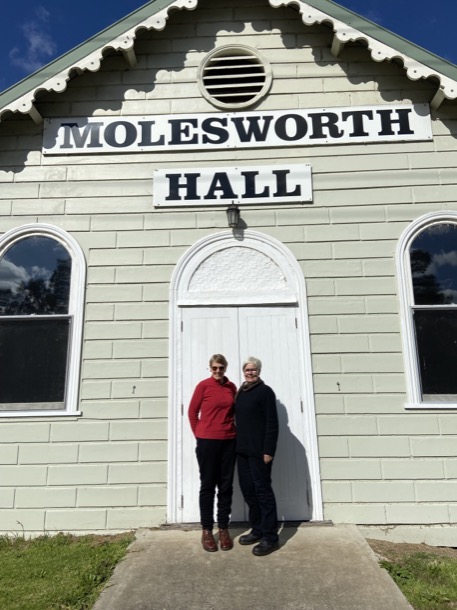
It wasn’t until I walked down the side of the building that the significance of it all hit me. There, on a hill behind the town strip, sat Balham Hill, the red brick house our grandmother grew up in. Her father had donated the land for the hall. We noted that the hill was much too steep for young ladies to navigate.
The right turn into Whanregarwen Road was very near. We parked in the clearing next to the Rail Trail, and Sue and I climbed a rough cutting until we could see Balham Hill again, in its home paddock.
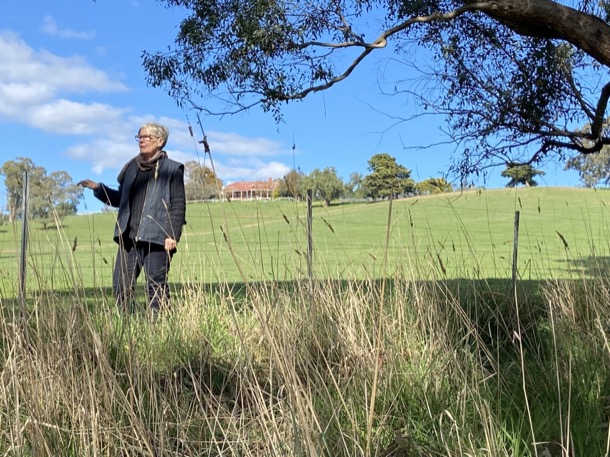
We turned to look out across the river to the hills beyond. What a view they had had. Not even the great 1870 flood would have reached the house perched right up there. And how close to the homestead the train line had been! The twice daily trains would have made their presence felt.
I thought about Grace, our grandmother growing up here, in this grand house, going to primary school in Molesworth, a short walk away. Her father, John, was an important man in the district, a Justice of the Peace and on the Yea council. When Grace was seven, the house had been extended and rebuilt.
A little further on we came across Balham Hill’s proper driveway, and a different view of the house. With her knowledgable eye, Sue noted the quality of the the land itself, and of the farming techniques, where many trees were left in the pastures.
With an eye on Google Maps, we drove on. The property up the road a bit had belonged to the previous generation: our great, great grandparents, James and Bridget Hamilton. We knew that they had selected the property, “Cremona” estate, 1220 acres, in 1866. It was “situated on the southern concave side of a great sweeping arc of the Goulburn River … rising to high ground in the south where it fronts the Whanregarwen Road.”
The "great sweeping arc” is still there, in spite of 150 years of floods and droughts. It means that the river leaves Whanregarwen Road at right angles. We stopped at that spot, looking out over the river flats. “This would have been Cremona land”, said Sue.
A farm bike pulled up alongside us. We can’t remember exactly what the man said, but it was something like “Can I help you?” but tinged with suspicion. As we wound down our windows, I thought of Chris’s quip about being ready to bail us out when we were picked up for loitering
After some explanations, Jono mentioned his and Sue’s nearby property on the Gobur Road, and it emerged that this young man, Matt Ridd, owned the business, Murrindindi Kitchens, who had put in their kitchen. The atmosphere warmed immediately, and Matt told us what he remembered of the old house at Cremona. His family, too, went back many generations in that area.
He was full of stories. The old house was gone before he was born, but he used to play around there, by the area known as the “old Cremona Drive”, where there were old bricks and things. There was an old brick lined well, down near the river, full of snakes. There had been a communal sheep wash at Balham Hill. We drank it all in eagerly.
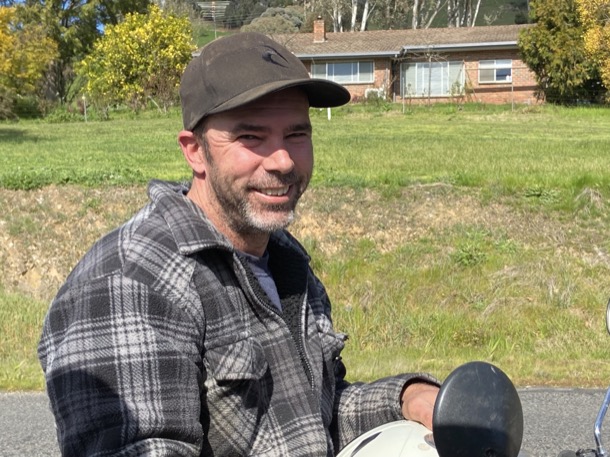
Eventually he turned his bike around and led us up the road, around the corner to an unmarked farm gate. We took photos, and pointed to twin lines of deciduous trees that could well have flanked Cremona’s driveway.
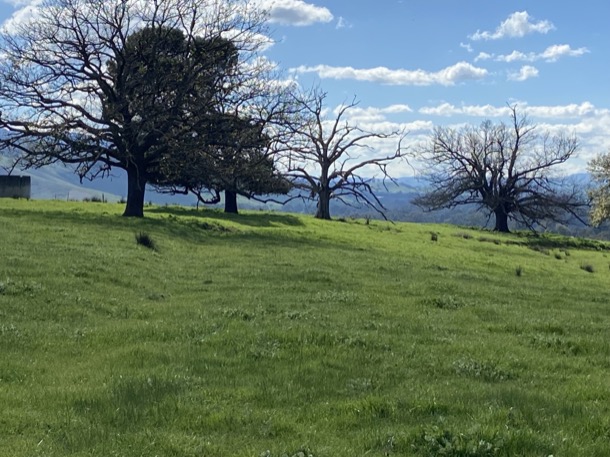
Off in the distance the river seemed a long way down. We had read the story of the 1870 flood surrounding and isolating the original house, and of James rescuing the family in the middle of the night, by crossing a flooded creek with horse and dray. Afterwards he rebuilt the house on much higher ground. Matt left us and we drove off in the other direction towards Alexandra.
As we drove, I pictured James driving his family to Sunday Mass along this road. The story goes that he would hurry up his daughters, complaining that his “Presbyterian horses couldn’t wait all day for lazy Catholics.”
The winding road down the hill into Alexandra from Cremona, is a familiar route for Jono and me. As we arrived in Alexandra, we were looking at the town with different eyes. We passed the impressive Shire Hall and Library and wondered whether any of the Hamiltons had graced the steps of either building. Charles Hamilton, James’s only son, and heir to Cremona was Shire president three times, so he may have even been involved in their creation.
The people with the answers are now in Alexandra Cemetery, our next destination.
We easily found the Catholic section with its assortment of Celtic Crosses, the tallest belonging to Charles’s wife Hannah, who died quite young, leaving two young children and a baby.
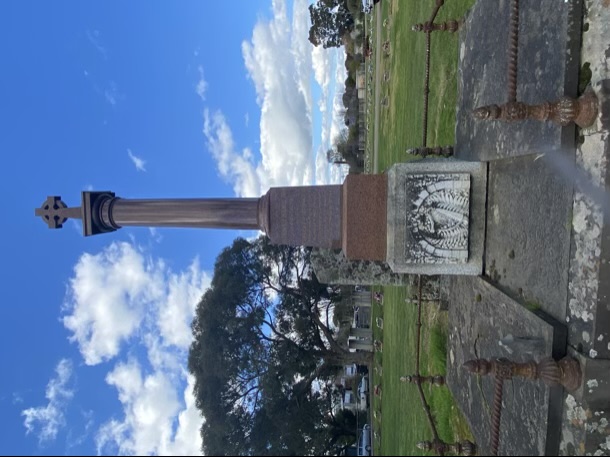
We did not find Charles or his parents in this section, so we decided to have Margaret’s salad rolls and a cup of tea in the sun and continue the search after lunch.
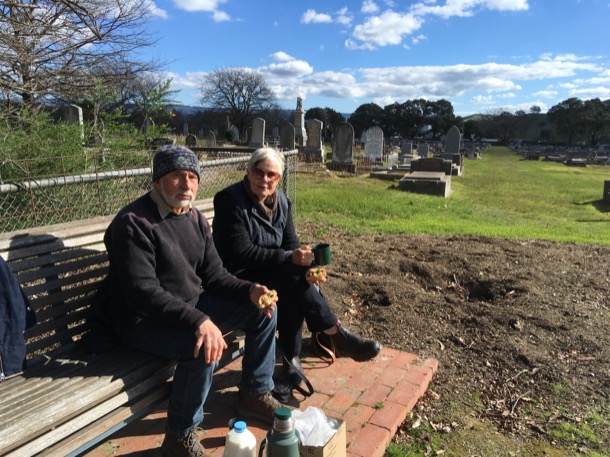
In the Protestant section, we did find more Hamiltons. Agnes, James’s mother, who emigrated with him, and James himself is also on the headstone. You may remember from our previous post, that they were both Protestants. Very fitting and buried in the correct section. Buried with them, is Brigid, who chose not to be buried in the Catholic section but here with her husband and mother in law. Their daughter Sara, who died at twenty-three, is also buried here. We did not find Charles although we do know he is buried at Alexandra too. Our excuse is that this was our first graveyard and we were not yet expert headstone hunters. I will return on my next trip into Alex with my new found expertise.
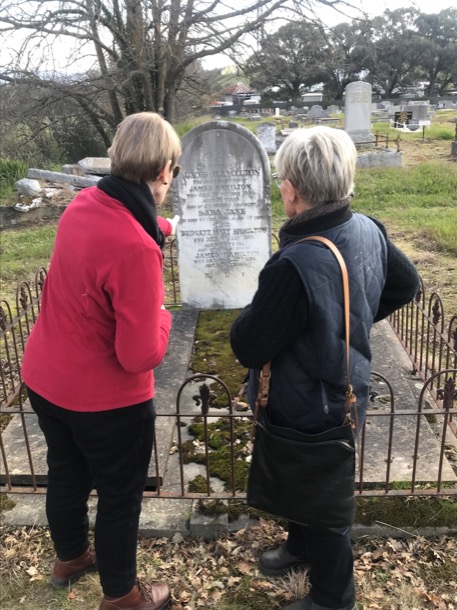
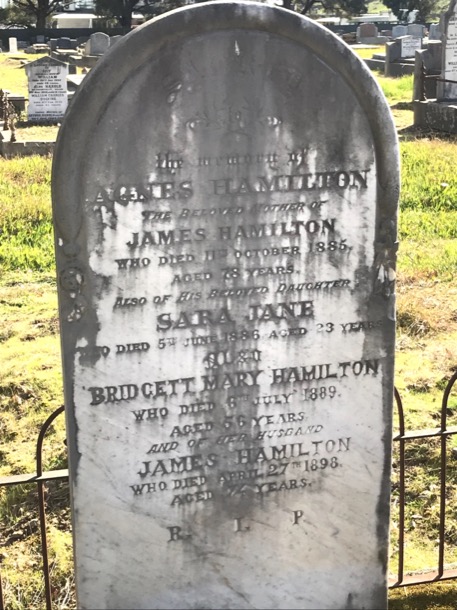
That night, in front of the fire at Sue and Jono’s house, as Jono cooked our Spanikopita dinner, Sue and I poured over our notes. I opened up and reread the 2006 article we had found in the journal “Eureka Street”, where Peter Hamilton, great grandson of the original Hamiltons of Cremona, describes his own visit to Alexandra cemetery, and the site of Cremona. Right there, in the article, was the name Les Ridd.
Matt Ridd, perched on his motorbike on the side of Whanregarwen Road, had described his dad’s recent illness, and here was a story about him taking Peter around Cremona in 2005.
Matt had given Sue his mobile number, and she texted him the link. Matt immediately rang back. Sue and Matt shared more stories. It was exciting to find that real world link with our past.
Later, on the strength of our interaction with Matt, I reached out to Peter Hamilton, author of the article. More about that in a later post.
The next morning, our first destination was Landscape at Tallarook. As we drove via Yea on the same route the young Hamilton girls would have taken, we again wondered how the three young ladies travelled to the Tallarook railhead and how long it took them. It took us fifty minutes on a good bitumen road.
Originally John McCormack Snr, of Red Barn, had bought the property, then called Tallarook House. Some of his sons had lived there, and, eventually one of them, James, became its long term owner.
After they were married, James and Grace changed the name of the property from Tallarook House to ‘Landscape.’ Archbishop Little in his small family history waxes lyrical about the property and the life there.
…….’Landscape’ a more fitting name for the unique and pleasant vistas of scenery viewed from its open wide verandahs.
After settling in at “Landscape”, husband and wife took a prominent part in the social, civic, charitable ,religious, and sporting life of the community and continued to do so throughout their lives. Landscape with its gracious hostess was a perfect setting…….
It is still is a beautiful, prime pastoral property. When it sold most recently in 2017, as a much reduced holding, it still boasted three kilometres of Goulburn River frontage.
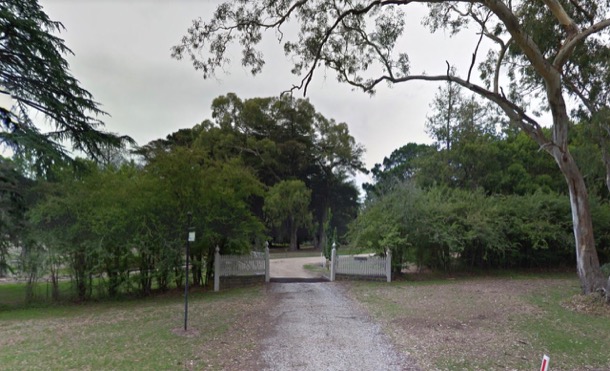
Landscape today still looks very much the gracious country house. It still sits amidst a cluster of small houses and large stone stables. The lovely old house overlooks the Goulburn and is set in a large well tended garden dominated by old stately trees. We wondered if James and Grace had planted the trees.
We wanted to stop and have a really good look, but the security cameras and the gentleman trimming the hedge were a little off putting. We settled for another drive past. On one side of the house Landscape now has its own vineyard, a more recent addition we think. Not so Tennis Court Paddock, on the other side of the house. No longer a tennis court, but we could imagine in days past it would have been a well used addition.
It was a short drive from Landscape to Tallarook. The old railway line, now a rail trail, had followed the road. It culminated in the Tallarook Railway Station, which is still in operation, on the main Melbourne to Sydney line. Back when James McCormack was establishing himself in the district, it was the railhead. Although much reduced in capacity and importance, it still has the feeling of a substantial, permanent structure. What had been high wide doors have been bricked in. There are a few historical signs, but it was hard to get a sense of the bustling, smelly, noisy place it once would have been. We took photos and moved on.
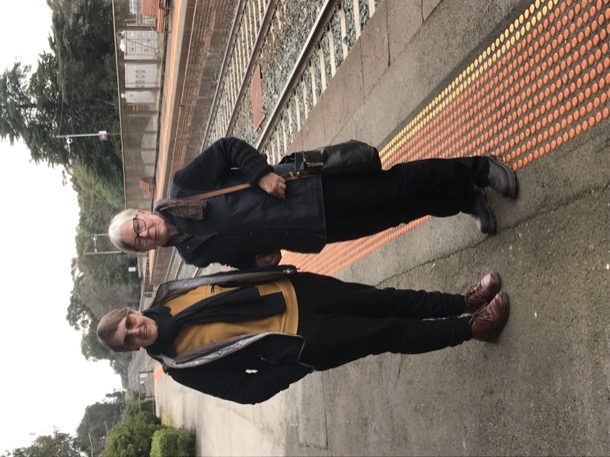
We drove into the grassy grounds of St Joseph’s. There is very little information about this church. It was blessed in July 3rd 1887 by Archbishop Carr.
It is sad to realise that this beautiful bluestone building is now virtually unused. It is not listed on the Diocese website.
Jono had sent an email to the Seymour parish priest the day before, in the hope that we might get a peek inside, but there was no reply.
The slate roof looked sound, and all the windows were intact, thanks to heavy wire screens on the outside of them. Archbishop Little tells us that “The memory of Grace and James McCormack has been retained in the Catholic community of Tallarook by the erection in St. Joseph's Church of ornate stained glass windows…”
We couldn’t really see the windows very well from the outside, but they looked substantial.
The only other buildings on the block were two little ramshackle outdoor dunnies, tucked under the trees on the outskirts of the cleared area.”
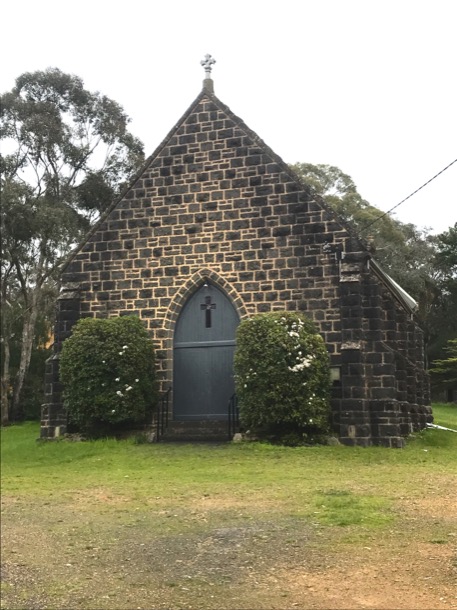
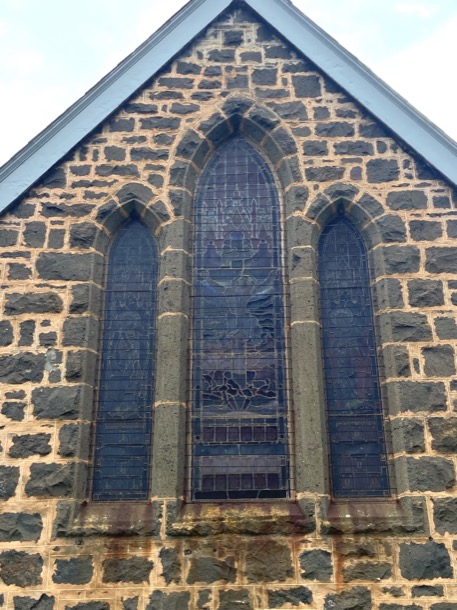
James and Grace had been dominating our thoughts in Tallarook, and now we drove on the the Seymour cemetery to find their graves.
Far from finding a quiet country cemetery, we found ourselves over the road from the busy midweek races at the Seymour Racetrack. Dodging horse floats, we turned right and parked in the cemetery grounds. We huddled quietly by the car, hoping that we weren’t intruding on a funeral still in progress. The land around Seymour is dry and stony, and heavy grey skies reminded us that rain had been forecast.
The sections in the cemetery were clearly labelled, and we headed toward the forest of Celtic Crosses in the Catholic section.
There were McCormacks everywhere. But the largest marble Celtic cross marked the graves of Grace, aged 56 and James JP (Justin of the Peace), aged 78.
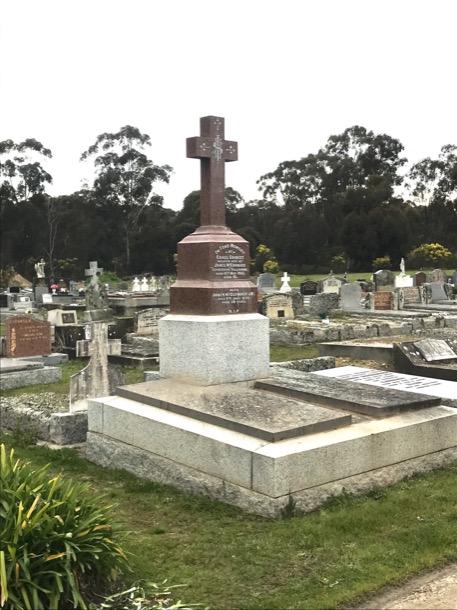
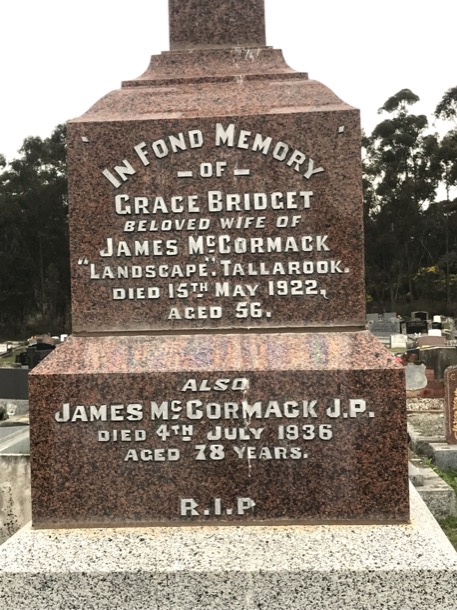
We drove through Seymour. I tried to see it as it had been when James was president of the Council, but the church has been rebuilt, the town has grown, and the sad, unkempt, crowded together little houses and struggling small businesses overpower any sense of history.
Rain was still threatening, and the wind was cold, as we pulled up at the Tourist Park alongside the river in Euroa. Parked a few cars away, was Janet, who Sue and Jono knew from Trust for Nature. Janet is a local landowner, active in all local environmental organisations and activities. She was cleaning up, after running a morning water-quality training session in the river.
When we explained our mission, she exclaimed, in her larger-than-life voice,
“Oh! Are you related to the McCormacks?”
“Yes, our grandmother was a McCormack.”
It felt real. We did belong to these people: men who had dominated four local councils and been part of all the important local infrastructure decisions for the second half of the nineteenth century, and the beginning of the twentieth. Families whose weddings were written up in the local papers, whose names were on the stained glass windows in the churches, whose memorials dominated the cemeteries.
We ate our egg sandwiches and drank tea from the thermos huddled in a shelter by the river. Euroa felt older, more solid and prosperous than Seymour.
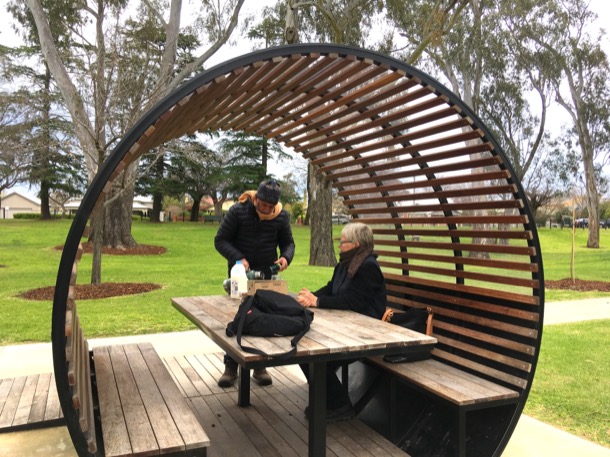
The Euroa McCormack was Thomas, the eldest of John and Jane’s children, born at Red Barn in Beveridge. We hadn’t spent much time exploring Thomas’s story, because we had been so taken by the romance of his younger brothers, James, John and Michael who had married the three Hamilton sisters. But here, in Euroa, it felt important to fit him into the story.
We had a few notes, (and a bit of subsequent expert input, to be explained later) and spent a bit of time pulling his story together.
Thomas was the eldest son of John and Jane McCormack of Red Barn Beveridge. He was born in 1851.
After living with his brothers James and Michael at Landscape, Thomas purchased a property in Mooroopna, near Shepparton, in 1882.
The property was called “The Desert”, and was in Toolamba Road. Like the other family properties, Thomas’s was along the Goulburn River, but much further north.
Soon after moving to Mooroopna, Thomas married Bridget Agnes Cooke, of Pyalong. There’s more to find our about this, but we think that Bridget’s brother John might have also invested in this property. Over time, it seems that the property developed into a “fine property” called May Park Estate.
Thomas and Bridget were active community members. In particular, Thomas was very involved with the Mooroopna Hospital Board. They had four sons and two daughters.
In 1908, Thomas and Bridget sold up in Mooroopna and bought “Springside” in Gooram, near Euroa. Thomas was 57, and Bridget, 55. It seems they immediately became involved in their new community.
In 1912, Bridget became sick with colon cancer. After a difficult two years, she died. She was 61.
Thomas remarried two years later, in 1916. We don’t know much about his second wife, Elizabeth. She was the daughter of Patrick and Elizabeth O’Connor of “Parkview”, Kilmore.
Then, in 1918, further tragedy struck. Daughter Mary, who lived with Thomas and Elizabeth at Gooram, died, aged thirty.
We can only speculate about Thomas’s motives, but, quite soon, he sold up and they moved into town. His new house was “Marengo” in Anderson St.
Thomas and Elizabeth had thirteen years together. It seems they built a busy, community-focussed life in Euroa. Among other things, Thomas was involved in the District Racing Club, the Agricultural Society, the Band, the Swimming Club and the Bush Nursing Hospital.
Thomas died in 1929, aged 78.
Elizabeth, who is buried alongside him in Euroa, lived in Hawthorn for a further fourteen years. She died in 1943.
Euroa Cemetery, like Seymour Cemetery, is in a rather uninspiring location. Separated from the town by the Hume Freeway, it sits amongst flat empty paddocks.
It was still cold and raining a little, as we approached the rows of graves, looking for the Catholic section and the telltale sign of the Celtic Crosses. Well practised now, we headed for the tallest cross.
Sure enough, we found the McCormack’s lichen encrusted, but still readable, very large granite Celtic Cross. Buried here are Thomas McCormack and Brigid, his first wife, and mother of his children, who died fourteen years before him. Only four years later, Mary their daughter also died, and is buried with her parents. Many years later, in 1943, Elizabeth, Thomas’s second wife, was also interred in this plot. She had lived in Hawthorn after Thomas’s death, but chose to be buried here with him.
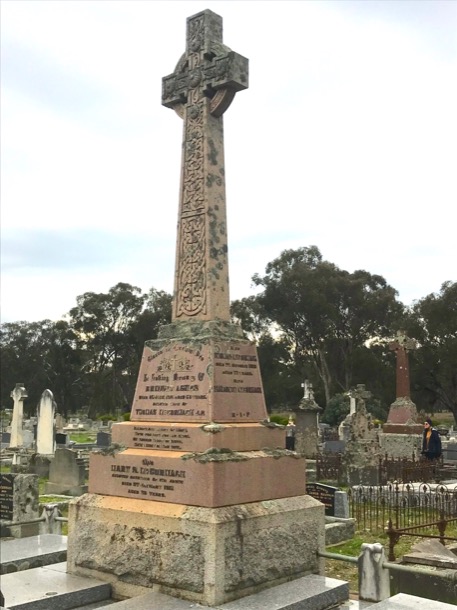
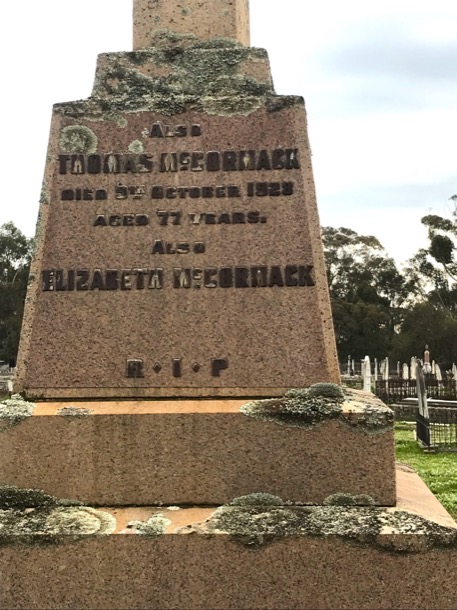
We were also fascinated to see, crowded in next to the McCormack plot, the priests and nuns of Euroa. Notably, the nuns' graves were a little smaller.
Having found Thomas’s grave we set off to find his property, Springside, at Gooram.
We drove into the Strathbogie Ranges on the beautiful Euroa-Merton Road for seventeen kilometres, and then turned right, onto a long straight road that followed the valley.
It was a lovely tree-lined road with only one or two properties along it. It seemed very remote to us. What must it have been like when Thomas and Brigid lived here?
The first indication that we were there, was a large new sign, ‘Springside’ at the beginning of a long drive that disappeared over the hill.
Of great interest though was the very large Banksia marginata on the road verge, right opposite the gate. There are very few original Banksia marginata left in the Strathbogie Ranges, and we had never seen such a large one. We wondered how old it was and if it had been growing there, as Thomas and family drove and rode past.
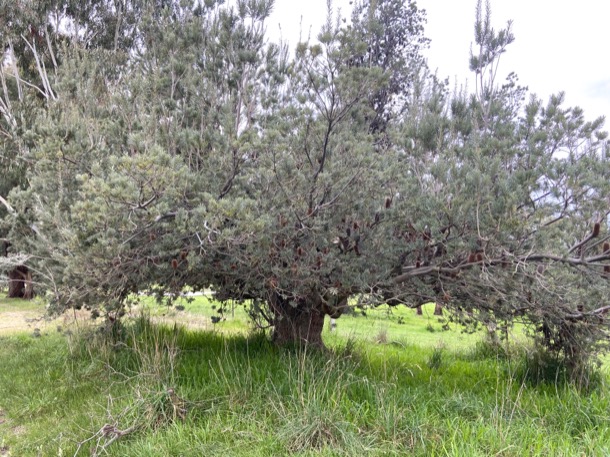
As no house was obvious here, we drove on. Almost at the end of the road, there was the house, sitting quietly in its old garden. It is not as grand a house as Landscape, but it looks substantial and comfortable. Thomas’s white, weatherboard house is surrounded on three sides by a wide verandah and we could imagine Thomas sitting on the verandah, looking across the lush paddocks to the distant hills, fires roaring in the fireplaces inside. It was certainly a lovely spot.
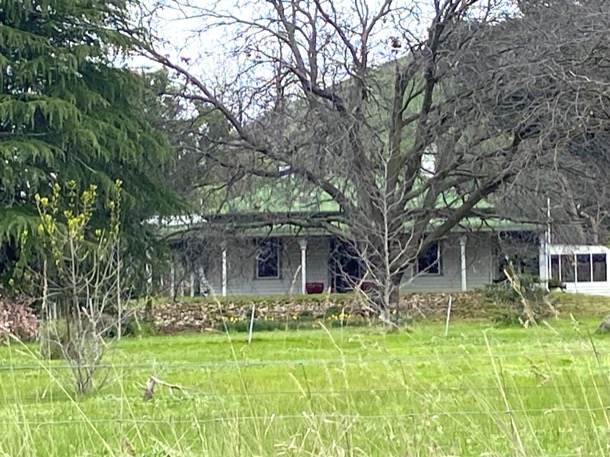
Our last day of graveyard hopping dawned cold and wet again. Very appropriate and atmospheric weather, and Yea Cemetery did not disappoint.
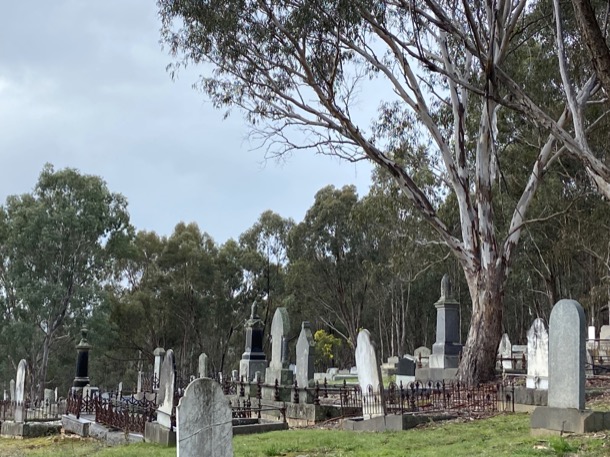
The old cemetery, surrounded by bushland, was tucked away on the hill, behind Yea township. The newer section of the cemetery, lies bland, uninteresting and uninspiring, out of sight.
Unlike all the other cemeteries that have been in flat and open expanses, Yea is set in a hilly spot. We arrived and walked up the small, treed hill, looking once again for the Catholic section. Not as many Celtic Crosses to guide us here and no clear signage. Near the top of the hill we began to see the Irish surnames, so the hunt for our great grandparents began in earnest. It was raining more heavily now, and we thought we were to be disappointed, but Jono saved the day.
Not a Celtic Cross, but a large impressive slab, with all that we sought buried here. It was sobering to think that our grandmother, Grace had stood here, as the bodies of John and Joan (previously called Johanna) McCormack, her parents, were interred. Maybe our father as a four year old child had been there too.
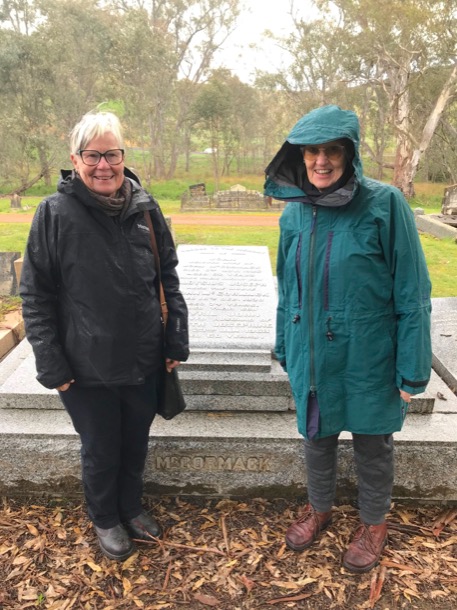
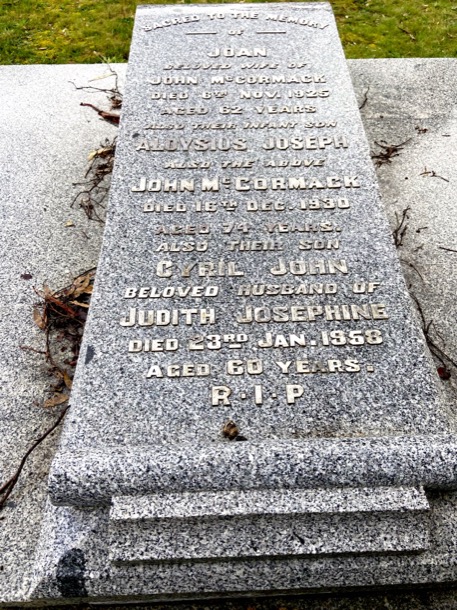
Also on the stone were John’s and Joan’s infant son Aloysius who died aged ten months and Cyril, Grace’s brother and his wife Judith. Quite a family plot.
What a beautiful little cemetery in which to end our journey around Central Victoria and how fitting to end it with the resting place of our great grandparents.

